Kiwi growers stunned by rates ruling

KIWFRUIT growers are grappling with punitive rate hikes of as much as 50% after a recent High Court ruling – in districts where urban ratepayers have faced only single-digit increases.

The court decision means kiwifruit growers with SunGold licences have seen their orchard valuation increase by the licence’s value, in most cases about $800,000 a hectare.
Previous rating valuations had not distinguished between conventional Green and SunGold vines as ratable “improvements”.
This month a Court of Appeal ruling upheld an earlier High Court decision ruling in favour of Gisborne District Council, which applied the increase to Gisborne grower Tim Tietjen. Tietjen and fellow growers now face the prospect of significant rates increases, thanks to the licence’s inclusion in valuations.
In his case that is a lift from $4000 a year to $8000 a year on his 5.8ha orchard, which includes 3.1ha of SunGold fruit.
Ōpōtiki kiwifruit grower Adrian Gault has already seen the Gisborne decision flow into his rates valuation for orchards and orchard interests across other kiwifruit-growing council districts of Western Bay of Plenty, Ōpōtiki and Whakatāne.
Three years ago, he experienced a 48% rates rise on his Ōpōtiki orchard and has just received another 44% increase on the block this year.
“My discussion with QV [the valuation company] indicates they have been instructed to include SunGold in the valuation.”
In a statement to Farmers Weekly, QV confirmed the last valuation of rates in Western Bay of Plenty, the main kiwifruitgrowing region, was completed in 2019 and did not include SunGold licences.

QV said that their inclusion in this revaluation has meant a significant increase in rating value for Gold Kiwifruit growers. Horticultural kiwifruit categories have increased by 54.2% in capital value and 47.2% in land value, on average over the whole of Western Bay of Plenty.
“This is highest increase of rural categories but a similar increase to the urban growth observed,” QV said.
However, rates increases in Western Bay of Plenty, Ōpōtiki, Whakatāne and Tairāwhiti have averaged only 9%, against the 50% surges growers are being hit with.
Rates on Gault’s 4.8ha Ōpōtiki orchard have gone from $8000 a year six years ago to $12,000 a year over the past three, and are poised to soar to $18,000 a year this year.

“Over the last 10 years the increase amounts to 20% a year,







Continued page 3
Ex-councillor opposes ‘council money grab’
Ōpōtiki kiwifruit grower Adrian Gault says the court decision to allow SunGold licences to be included in rates valuations leaves growers facing massive surges in their rates bills.
Global charity trucks in fencing supplies
Rapid Relief Team brings in enough material for 250 Hawke’s Bay properties hit by Cyclone Gabrielle and its flood devastation.
NEWS 8
Admirable farming practices chime with consumers’ post-covid world view, SFF conference hears.






MARKETS 4
The directors of six National Science Challenges have called for a National Food Strategy for New Zealand.
NEWS 12
The speed of change – too fast, too slow – is tough for everyone but they’re trying, writes Daniel Eb.
OPINION 17

1
Vol 21 No 28, July 24, 2023 View online at farmersweekly.co.nz $4.95 Incl GST Sizzling win
Hawke’s Bay butchery 9
for
Richard Rennie NEWS Horticulture
EDITORIAL
Bryan Gibson | 06 323 1519
Managing Editor bryan.gibson@agrihq.co.nz
Craig Page | 03 470 2469 Deputy Editor craig.page@agrihq.co.nz
Claire Robertson
Sub-Editor claire.robertson@agrihq.co.nz
Neal Wallace | 03 474 9240
Journalist neal.wallace@agrihq.co.nz
Gerald Piddock | 027 486 8346
Journalist gerald.piddock@agrihq.co.nz
Annette Scott | 021 908 400
Journalist annette.scott@agrihq.co.nz
Hugh Stringleman | 09 432 8594
Journalist hugh.stringleman@agrihq.co.nz
Richard Rennie | 027 475 4256
Journalist richard.rennie@agrihq.co.nz
Nigel Stirling | 021 136 5570
Journalist nigel.g.stirling@gmail.com
PRODUCTION
Lana Kieselbach | 027 739 4295 production@agrihq.co.nz
ADVERTISING MATERIAL
Supply to: adcopy@agrihq.co.nz
SUBSCRIPTIONS
0800 85 25 80 subs@agrihq.co.nz
PRINTER
Printed by Stuff Ltd
Delivered by Reach Media Ltd
SALES CONTACTS
Andy Whitson | 027 626 2269 Sales & Marketing Manager andy.whitson@agrihq.co.nz

Steve McLaren | 027 205 1456 Auckland/Northland Partnership Manager steve.mclaren@agrihq.co.nz
Jody Anderson | 027 474 6094 Waikato/Bay of Plenty Partnership Manager jody.anderson@agrihq.co.nz
Palak Arora | 027 474 6095 Lower North Island Partnership Manager palak.arora@agrihq.co.nz
Omid Rafyee | 027 474 6091 South Island Partnership Manager omid.rafyee@agrihq.co.nz
Debbie Brown | 06 323 0765 Marketplace Partnership Manager classifieds@agrihq.co.nz
Andrea Mansfield | 027 602 4925 National Livestock Manager livestock@agrihq.co.nz
Real Estate | 0800 85 25 80 realestate@agrihq.co.nz
Word Only Advertising | 0800 85 25 80 Marketplace wordads@agrihq.co.nz
PUBLISHERS
Dean and Cushla Williamson Phone: 027 323 9407 dean.williamson@agrihq.co.nz cushla.williamson@agrihq.co.nz
Farmers Weekly is Published by AgriHQ PO Box 529, Feilding 4740, New Zealand
Phone: 0800 85 25 80 Website: www.farmersweekly.co.nz
ISSN 2463-6002 (Print) ISSN 2463-6010 (Online)
brief
Wickham appointed
Former Fonterra executive Kelvin Wickham has been appointed chief executive of Ballance Agri-Nutrients.

CEO Mark Wynne will leave Ballance at the end of September after nine years in the role. Wickham said he was grateful for the opportunity to lead Ballance, which has an important part to play in New Zealand’s economic engine.
New Riddet chair
Former parliamentary speaker of the house and education minister Sir Lockwood Smith is the new board chair of the Riddet Institute in Palmerston North.
Sir Lockwood replaces Stuart McCutcheon, who passed away early this year. The Riddet Institute is a Centre of Research Excellence), hosted by Massey University in Palmerston North, focusing on advanced food research.
Food inflation up
Statistics New Zealand reported annual food inflation was up 12.5% in June, driven by a 22% jump in fruit and vegetable prices and a 12.8% hike in groceries.
That matched April’s percentage change and is the highest annual change to the food price index since September 1987, when it was 15.8%. Key drivers for fruits and vegetables were tomatoes, capsicums and lettuce, while grocery items like fresh eggs, yoghurt and cheddar cheese bit hardest into supermarket spending.
Confidence rises
Sentiment among New Zealand farmers has lifted slightly but overall remains deep in negative territory due to a wide-ranging mix of farmer concerns, the Rabobank Rural Confidence survey says.
The June survey found farmer confidence in the broader agricultural economy was up marginally on the previous quarter with the net confidence reading rising a single percentage point to minus 57%. Farmers were also more positive about the prospects for their own farm business performance.

Cosiest socks you’ll ever wear 03 377 0365 www.wyld.co.nz LK0116066© 2 New Zealand’s most trusted source of agricultural news and information Contents Advertise Get in touch TOP EARNER: Zespri chief executive Dan Mathieson told the China Business Summit that 25% of NZ kiwifruit are consumed in China, which is a $1 billion market for the single-desk exporter. STORY P10 News . . . . . . . . . . . . . 1-13 Opinion . . . . . . . . . 14-17 People . . . . . . . . . . . . . 18 Technology . . . . . . . . . 19 World . . . . . . . . . . . . . . 20 Real Estate . . . . . . 21-22 Marketplace . . . . . 23-25 Livestock . . . . . . . . . . . 25 Markets . . . . . . . . . 26-31 Weather . . . . . . . . . . . . 32
News in
Fonterra ramps up its own emissions goals
Gerald Piddock NEWS Emissions
FONTERRA has brought forward its target for Scope 1 and 2 emissions reductions in its manufacturing and supply chain operations by accelerating some of its work to exit coal.
Fonterra chief executive Miles Hurrell said the co-op is targeting a 50% absolute reduction in Scope 1 and 2 emissions by 2030, from a 2018 baseline, an increase on its previous target of a 30% reduction by 2030.
“Fonterra’s Scope 1 and 2 emissions largely come from our manufacturing operations and supply chain,” Hurrell said.
“Strengthening our emissions reduction target supports our ambition to be net zero by 2050.”
Achieving the new target will require Fonterra to continue to undertake energy efficiency improvements and fuel switching to renewable energy source activities across its milk collection fleet and manufacturing sites, with a focus on the six sites where coal is used.
The projects will result in 2.1 million tonnes of earlier CO2e reductions. The reductions are the
Continued from page 1
with no additional services provided. It is robbery.
“When they got their valuations, a lot of growers probably did not connect the dots on what the increased value meant, that it’s used for rating purposes.”
With 10 years of council experience behind him, Gault maintains councils have other tools like targeted charges and uniform annual payments to moderate rates charges to commercial growers and farmers, many who benefit least from council services.
However, he said councillors are
same as taking 120,000 cars off the road.
To do this, Fonterra is forecasting an investment of $790 million, including a government contribution of up to $90m through the Government Investing in Decarbonising Industry fund. The fund is paid for through the Emissions Trading Scheme.
“As a co-op, Fonterra understands how we can achieve more by working together. The addition of government funding enables us to lift our 2030 ambition to reduce Scope 1 and 2 emissions by 50% and optimise our process to get out of coal by 2037.
“Our decarbonisation plan will see us explore multiple technologies to ensure the most efficient phase-out of coal and transition to renewable energy across our manufacturing sites, while building resilience into our operations.
“We are already well underway with shifting our manufacturing operations to renewable energy sources. Over the past five years, we have carried out decarbonisation projects at five different sites and we’re looking forward to continuing this momentum.”
Hurrell said Fonterra is currently assessing biomass, electrification
choosing not to use them, opting instead for a less transparent and outwardly simpler general rate.
He said the adoption of SunGold licences into rating values is a money grab on operators in districts where councils use rating valuation to determine supposed ability to pay.
“This comes despite us losing $400,000 on our Green crop across 8ha this season.”
The decision also has other horticultural sectors concerned over what the decision will mean for their licensed fruit varieties.
Pipfruit New Zealand grower director Evan Heywood of Nelson said the decision sets a precedent
and heat pump technology at its Clandeboye and Edendale sites.
“We see these technologies as the best solutions possible at this stage.”
“Accelerating our plans will help Fonterra continue to present our customers with the world’s lowest carbon dairy at scale. It will also contribute to New Zealand meeting its climate targets while delivering benefits across regional New Zealand, such as job opportunities in local communities,” Hurrell said.
Prime Minister Chris Hipkins said it was a hugely significant commitment that meant the dairy sector will dramatically cut its coal use quicker.
“This is not just critical for our environment, but for our economy too,” Hipkins said.

“By partnering with Fonterra to reduce emissions we’re helping to maintain New Zealand dairy’s competitive edge, as international consumers and food manufacturers demand further climate commitments.
“In my recent trade missions, I’ve heard first-hand the importance of New Zealand’s climate credentials to our exports. This partnership is an investment in our future economic prosperity.”
He said the partnership “delivers
for apple growers who purchase licences to grow higher value apples including Envy and Rocket.
“I think this may be the reality now and if so, it has big implications for growers.”
He noted licence values tend to fluctuate, raising the question about how much of a rates reduction would occur if the value dropped.
Federated Farmers rates expert Nigel Billings noted that a disparity already exists between pine trees on forestry land that are not included in rating valuations, compared to perennial crops like kiwifruit, grapes, and apples, which are.
a big chunk of New Zealand’s overall pollution cuts”. The project was launched at
But Billings said the decision to target SunGold licences appears particularly punitive and only adds to existing imbalances within council rating structures.
“In town you do not distinguish between what two commercial properties are selling and earning when it comes to rates. A SunGold licence is not an improvement to the land, it is a licence whose value is theoretical.”
At the High Court hearing kiwifruit growers also argued that a rating based on a SunGold licence’s value is effectively an additional tax, when any additional earnings gained from the licence should be paid as income tax.
Fonterra’s Hautapu site by Hurrell, Minister of Energy and Resources Megan Woods and Climate Change Minister James Shaw.
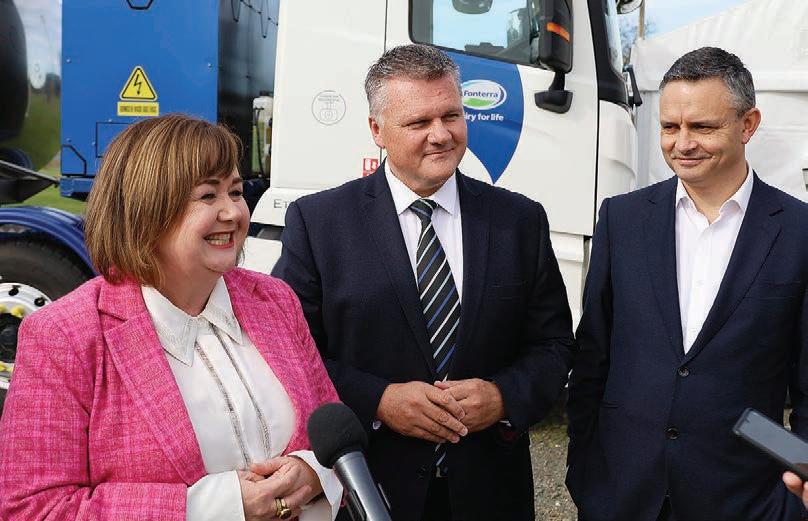
Hurrell said Fonterra is currently talking with farmers about a Scope 3 emissions target, which will be announced shortly.
Fonterra’s climate targets are aligned to the Science Based Target initiative, which means they’re aligned to limiting global warming to 1.5degC. The process of seeking accreditation is underway.
New Zealand Kiwifruit Growers Incorporated CEO Colin Bond said growers have to accept that legal remedies have been exhausted, but four other options are now being pursued: Growers can object to councils about their valuation and seek a revaluation; NZKGI will ask councils to exercise their right to soften the impact of how they implement the decision; NZKGI will discuss the issue with property valuers QV; and the grower group will work with HortNZ to ensure the organisation is aware of the wider consequences for other licensed fruit varieties, particularly apples.

3 FARMERS WEEKLY – farmersweekly.co.nz – July 24, 2023 News 3 farmersweekly.co.nz/everyday farmersweekly.co.nz We’re online NZ’s most trusted source of daily agricultural news and information is also a website.
COAL GOAL: Fonterra CEO Miles Hurrell, pictured at the launch event with Minister of Energy and Resources Megan Woods and Climate Change Minister James Shaw, says the addition of government funding ‘enables us to optimise our process to get out of coal by 2037’.
Accelerating our plans will help Fonterra continue to present our customers with the world’s lowest carbon dairy at scale.
Miles Hurrell Fonterra
NZ farmers ‘have what the world wants’
Neal Wallace NEWS Food and fibre
FORGET sustenance –global consumers want nourishment, and not just from the food they eat.
That was the message from Dan Robertson-Jones, a director of consumer insights company Kantar Consulting, who said the market disruption unleashed by the covid pandemic has changed the way consumers approach their food, lives and values.

Add to that Russia’s war on Ukraine, artificial intelligence and climate change, and he said global consumer trends have been altered forever and will continue to change.
“It’s been one thing on top of another, on top of another, on top of another and it’s not going to stop.”
We have undertold and undersold the story of NZ to the world.
Dan Robertson-Jones Kantar Consulting


Robertson-Jones told about 700 farmers attending a Silver Fern Farms (SFF) conference in Christchurch that after World War II the world wanted food that provided sustenance. This was provided by the growth of supermarkets.
Now covid has caused people to reflect on their lives, the food they want, the lives they lead and the values they hold.
Research shows consumers want more control and to reconnect with nature, and that means nourishment through the food they eat.
They see nourishment not only from eating authentic food but from mixing with people, caring for and connecting to the planet and having more control of their lives.
His research shows 90% of people are concerned at the loss of natural habitat and green


spaces and 97% want to live more sustainable lives.
Robertson-Jones said food producers that can meet those expectations have a “rare and desired” marketing opportunity.
Consumers will not be bluffed.
If they do not believe products are fulfilling their stated aims, they will cut those products loose.
Large-scale industrial food producers and plant-based meat alternatives will struggle to get cut through as they will not meet these expectations.



“[You] have what the world wants, a nourishment business,” he said of SFF.
New Zealand farmers follow sustainable practices to produce high quality meat, adhere to high levels of animal husbandry and have strong links to people and communities, he said.

“We have undertold and undersold the story of NZ to the world.”
Nicola Johnston, SFF’s manager of growth, said the introduction of Net Carbon Zero beef, soon to be joined by Net Carbon Zero lamb, and its soonto-be-launched Nature Positive programme, are part of telling that food story.
Nature Positive will show how farmers work in balance with the environment, the soil, water and biodiversity.
“Nature Positive is about the balance sheet of a farm’s natural capital.”

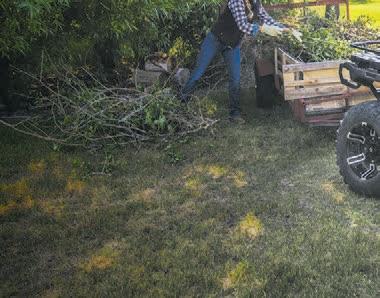
She said it will appeal to consumers’ emotional mood and their desire to connect to a healthy environment, for which they will pay a premium.
The conference, titled The Farmers the World Needs, acknowledged stock prices have fallen and could stay lower than previous years for some time yet.
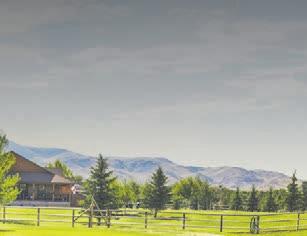
The call, repeated by successive speakers, was for SFF suppliers to stay on task.
To avoid future fluctuating prices, producers and exporters need to supply meat that meets the requirements of affluent consumers.
Plate to pasture to winner’s podium
RECOGNITION: North Canterbury farmers Jock and Pip Foster, right, with their second in charge George Satterthwaite, are this year’s Silver Fern Farms Plate to Pasture Award winners. Trading as Raumati Stock, the Fosters farm 1250ha near Scargill. The award recognises their ability to supply in-spec stock from a farming system that enhances biodiversity and the environment.

POLARIS FIELD DAY SPECIALS IN STORE NOW *Offer ends 31/7/23 or while stocks last. Offer only available at participating Polaris Dealers. Not valid with any other offer. Excludes fleet clients. ^^Accessories offer only valid with the purchase of a new Sportsman 570 Premium, Ranger 570 HD EPS ADC, Ranger XP 1000 HD EPS ADC. +Finance offer is only available on selected models. GST registered customers only. 24-month term contract. 20% Deposit required. Deposit may include Trade (Trade conditions apply). Fees and conditions apply (normal lending criteria applies) Finance is provided by Polaris Finance, a program operated by De Lage Landen Limited Company No 135515. FW200423 570 HD EPS ADC XP 1000 HD EPS ADC (09) 294 8585 | 267 Great South Road, Drury, Auckland 2113 0800 440 290 | www.polarisnewzealand.com | /PolarisNZ | /polarisorv_nz 570 PREMIUM $1,000 FREE ACCESSORIES^^ 3.99% FINANCE P.A+ $2,000 FREE ACCESSORIES^^ 6.99% FINANCE P.A+ $2,500 FREE ACCESSORIES^^ 6.99% FINANCE P.A+ 44 HP 82 HP ON DEMAND TRUE ALL-WHEEL-DRIVE (AWD) HIGH PERFORMANCE ON DEMAND TRUE ALL-WHEEL-DRIVE (AWD) 612KG TOWING CAPACITY KG DUMP BOX CAPACITY - 454KG ELECTRONIC POWER STEERING 41KG FRONT / 82KG REAR RACK CAPACITY KG 41/82 VERSATRAC TURF MODE ELECTRONIC POWER STEERING ENGINE BRAKING SYSTEM & ACTIVE DESCENT CONTROL (ADC) HEAVY DUTY FEATURES 44 HP VERSATRAC TURF MODE ON DEMAND TRUE ALL-WHEEL-DRIVE (AWD) ENGINE BRAKING SYSTEM & ACTIVE DESCENT CONTROL (ADC) IRS WITH 25.4 CM OF TRAVEL DUMP BOX CAPACITY227KG 4 FARMERS WEEKLY – farmersweekly.co.nz – July 24, 2023 News 4
SUNLIT: SFF says its new ‘Nature Positive’ campaign will appeal to consumers’ emotional mood and their desire to connect to a healthy environment.
Lean, mean season ahead for dairy farms
making decisions on the move. Reactionary responses based on emotion.”
AFALLING global milk price and a dry, windy El Niño summer mean a challenging season ahead for the dairy sector, a new report from BakerAg warns.
The farm consultancy firm’s annual Dairy Systems Monitoring Report says it expects the coming season to be lean.
It calculates that the average farm in the group it monitors is likely to have only 50 cents per kilogram of milk solids for tax, principal repayment and capital expenditure.
“Not easy when the last three seasons have delivered up to $2.50/kg MS of discretionary cash,” it says.
That figure is based on an $8/ kg milk solid milk price, along with 70 cents of other revenue using $6.53/kg MS of cash working expenditure, resulting in a cash operating result of $2.20/kg MS.
Factored into this is $20/kg MS debt at 8.5% interest, which equals $1.70/kg MS of debt servicing.
The analysis across its monitored farms for the previous season showed that a 13% drop in milk price coupled with an 8% increase in operating expenditure delivered a 46% drop in EBIT ($/ha).
The report is based on the financial results of 50 farms across New Zealand that work in a range of systems.
BakerAg urged farmers to plan now for what may follow this season.

“We are about to navigate a period of low commodity prices, which can be extremely stressful for some. Part of that stress is driven by a lack of planning. Typically, these farmers are
On top of the financial squeeze is the expected El Niño weather pattern this summer.
“We will need to be prepared for drier, windy conditions this summer.
“While we might briefly appreciate drier soils it could be that an early summer drought could eventuate.”

Know where the sweet spot is in your business and get there early this year. Get there before the El Niño bites.
The report suggested those with good records look back at the springs of 1987, 1991, 1993, 1994, 1997, 2002, 2006, 2014 and 2015 for guidance around rainfall and pasture production.
BakerAg consultant and report author Chris Lewis said a year ago, there was a mindset that farmers would be looking at a $10/ kg MS milk price and a $6/kg MS operating structure based on the then future market.

“They started the season like that, and they got squeezed.”
The subsequent reduction in milk price combined with the cost increase shifted the goalposts, he said.
“It didn’t just shift those goalposts a metre back or sideways, it shifted them right around the other side of the paddock.
“The consequences of that, is that what had worked for people the previous year didn’t work in the season just finished.”
Within the monitored farm group, the ones that emerged in the top five were those that used supplementary feed sparingly and showed a lot of discipline in their cost structure.
“They had a tighter, leaner farm feeding system. While there were some other defining points, those were the ones that really stuck out.”
The new season has a tighter milk price along with inflationary pressures affecting costs and as a result, that lean approach will have to continue, particularly around supplementary feed, he said.
“They must scrutinise.
“The more intensive your farm system is, the more you are relying on other feeds, the harder you are going to have to scrutinise your farm system.”
They will have to be extremely diligent if they are going to break even this season.
Lewis also acknowledges that is challenging, given the current conditions on many North Island farms that are contending with waterlogged pastures with low cover.
For them, looking after their core asset – their cows and their staff – is key and should not be compromised.
But for other spending decisions within the farm business, they must ask not only what it costs, but also what are its benefits.

“Don’t cut costs for the sake of cutting costs.”

If farmers look after their herd for the next 60-90 days, it will look after farmers during peak milking.
As well as scrutinising spending, farmers should also prepare now for a possible dry summer by watching their stocking rate in late spring and locking in cheap sources of supplementary feed that can get them through, rather than relying on the spot market, he said.
“Know where the sweet spot is in your business and get there early this year. Get there before the El Niño bites.”
Lewis said he was confident farmers can do it.
“We have been through these cycles before.”
Food cost increases slowing down
Hugh Stringleman MARKETS Food and fibre
PRICE rises for grains, flour and potatoes underpinned high costs for supermarket bakeries and chilled foods during June, the Foodstuffs co-operatives report.
However, the rate of increase in suppliers’ charges for goods to supermarkets is moderating, according to a monthly survey conducted by Infometrics and commissioned by Foodstuffs. Infometrics chief executive and principal economist Brad Olsen said food prices are still rising but the rate of increase is slowing.
Olsen said monthly increases in the past three months have been less intense than the considerably larger rises in late 2022, but they are still about triple the monthly rate seen pre-pandemic.
“It’s important to stress that actual costs aren’t falling overall – far from it – but cost increases aren’t as fast-paced as they have been before, a sign of easing pressure on costs generally.”
The Grocery Supplier Cost Index (GSCI) was 8.5% in June compared with a year earlier, which was an improvement on the 8.8% recorded in May.
Meanwhile the government has appointed the country’s first grocery commissioner, former Sanitarium general manager Pierre van Heerden.

Commerce Minister Duncan Webb said Van Heerden is an experienced chief executive and board member, with deep knowledge of the grocery industry in New Zealand, Australia and the United Kingdom.
He will also join the board of the Commerce Commission.

LAN3005 PUT THE GEAR TO WORK BEFORE YOU PAY FOR IT! Buy a JCB Series III LOADALL, CLAAS ARION 410, 430, 620C or 640C - and there'll be no repayments until March 2024. Scan QR code to learn more. *T&Cs: 0% for deferral period until first repayment March 2024, 20% initial deposit and GST month 3. Blended rate overall of 4.99%. Standard CLAAS Financial Services lending criteria, terms, conditions, and fees apply. The offer applies to all new JCB Series III LOADALL and new CLAAS ARION tractors models 410, 430, 620C and 640C only. Offer valid until 31/07/2023 or while stocks last. If finance base rates move by more than 0.25%, CLAAS Financial Services reserve the right to requote. Images illustrative only. For your local dealer go to: claasharvestcentre.com * 5 FARMERS WEEKLY – farmersweekly.co.nz – July 24, 2023 News 5
Gerald Piddock MARKETS Dairy
TIGHT TIMES: BakerAg consultant Chris Lewis says dairy farmers will have to be extremely diligent if they are going to break even this year.
Chris Lewis BakerAg
Network pins hopes on new rural strategy
Neal Wallace NEWS Health
THE launch of a rural health strategy is a chance to finally address many of the health discrepancies facing rural communities, the Rural Health Network says.
Jeremy Webber, the clinical director of the Rural Health Network (Hauora Taiwhenua), said he is hopeful it will address issues such as a shortage of health professionals working in rural practices and improve access to services.


“This gives us hope, which is something we haven’t had in a long time in rural health.”
He welcomes the fact that the strategy is ambitious, saying it needs to be bold to fundamentally address current issues rather than be another Band-Aid solution.
The strategy, initiated by the Ministry of Health, sets the direction for improving the health and wellbeing of rural communities over the next 10 years.
“Our vision is for all people living in rural communities to live long and healthy lives, supported by a health system that meets the varied needs of these communities and draws on the strengths and knowledge of rural communities to achieve pae ora –healthy futures,” a spokesperson said.
The strategy prioritises rural communities with the aim of providing services that meet their needs rather than adapting those designed for urban settings.
Another focus is to provide more preventative health interventions, such as screening, and to promote health and wellbeing.
It also aims to provide services closer to those living in rural communities through health providers, outreach programmes and digital options, but if this is not possible, communities must be supported to travel to access services.
The final priority is to grow and support the rural health workforce. “Making sure rural roles are better valued and supported is a key part for attracting and retaining our people,” the spokesperson said. That includes creating career pathways and increasing interdisciplinary rural placements to attract more people into rural health.
The spokesperson said the needs of rural communities are often under-served by access to services, especially for remote communities and rural Māori, and a focus is to
remove geographic differences in care and outcomes.
“The different needs of rural communities have not been considered in funding and planning health services, and
rural health outcomes were not monitored like other population groups,” the spokesperson said. Webber said the network was consulted in the development of the strategy.
His hope is that in five years there will be a marked improvement in the number of clinicians wanting to work in rural practices, seeing it as a rewarding and stimulating career, enhanced by improved training systems.
One of the issues the strategy aims to address is improving vaccination rates for rural twoyear-olds, which are lower than in urban areas.

A University of Otago study released last week found amenable mortality rates for rural people were in some demographics twice that of those in urban areas.
The study found results were worse for those aged under 30 living in the most rural communities, where mortality rates were double that of the most urban centres at 599 urban deaths per 100,000, compared with 1085 rural.
The spokesperson said the study confirms findings in Australia, Canada and the United States, where rural mortality exceeds urban.
“We know that reasons for this disparity is complex and affected by several factors, such as socioeconomic status and ethnicity, but also access to health care and experiences people have when receiving care.”
Crisis looming for Aus, NZ vet services
shortcomings in the education system, requiring a collaborative effort from all involved parties,” she said.
“I am optimistic that this report will play a vital role in fostering positive transformation.”
and preventative animal health programmes.
THE veterinary profession on both sides of the Tasman is approaching a crisis, warns a new report by Veterinary Schools of Australia and New Zealand.

The report, Rethinking Veterinary Education, warns this looming crisis is being driven by changing and complex needs for vets and more pressure on universities to trim costs and transform their teaching and research offerings.
It also warns the supply and retention of new vets for large and small animal practices cannot keep pace with increasing demands from animal owners.
“Current approaches to veterinary science education, research and service delivery will not be sustainable nor allow delivery of Australasia’s long-term needs for veterinary workforce renewal and enhanced research capability,” it says.
NZ Veterinary Association
President Kate Hill said the challenges facing the sector in Australasia can only be solved if all stakeholders contribute to positive change.
“The issues encountered by the veterinary schools in Australasia are indicative of broader
The report says training needs to change.
Where once vets were required to diagnose and deal with health issues in the field with few specialist facilities, most of those issues can be prevented and managed by vaccines or herd and flock management.
“There are, however, increasing demands from larger producers for holistic farm advisory services
“These need an in-depth knowledge of farming systems and more analytical skills from largeanimal practitioners.”
Demands have also changed for vet roles in biosecurity, food safety and public health.
A 2019 survey of NZ vets found 40% were in mixed, dairy cattle, equine or large-animal practice, 38% were in companion animal practice and 10% in regulatory work.
The report’s recommendations include establishing a strategic change fund to allow resource sharing of specialisations between the veterinary schools, along with increased government support to address the gap between costs and funding, which it says is the greatest in the higher education sector.
Vet practices also need improved professional support to attract and retain graduates along with extending mentoring schemes, broadening student input criteria and debt relief for vets working in rural and regional areas through a bonding scheme.
The report notes a rural practice bonding scheme has proven successful in NZ, supporting 416 graduates since starting in 2009.
Participants are eligible to
$55,000 before tax over five years, provided they meet certain conditions.
The report notes Veterinary Science courses at both undergraduate and postgraduate level are among the most expensive professional courses for universities.
That high cost is in part due to competence requirements for new veterinary graduates that are higher than those for disciplines such as medicine and dentistry.
New veterinarians, for example, are expected to be competent at graduation in skills such as primary clinical diagnosis and treatment of disease, anaesthesia, dentistry, and surgery.
In NZ, the Veterinary Science tuition subsidy paid by the government in 2022 was $32,516 per EFTS, up 10% from 2021, still far less than the tuition subsidy paid for dentistry and medicine of $55,519 and $45,779, respectively.
Domestic student tuition fees for Veterinary Science were approximately $13,000 per student.
The NZ Tertiary Education Commission confirmed that Veterinary Science funding rates are set at a level that requires cross-subsidisation by Massey University.
6 FARMERS WEEKLY – farmersweekly.co.nz – July 24, 2023 News 6
EARLY INTERVENTION: A key focus of the new rural health strategy is the provision of more preventative health interventions.
This gives us hope which is something we haven’t had in a long time in rural health.
Jeremy Webber Rural Health Network
Neal Wallace NEWS Veterinary
TREATMENT: A report on the state of veterinary education in New Zealand and Australia concludes that training models need to change.
Current approaches will not allow delivery of Australasia’s longterm needs for veterinary workforce renewal.
Rethinking
Veterinary Education
Housing NZ takes a new look at carpet requirements
Neal Wallace NEWS Food and fibre

THE material used in carpets and furnishing in state houses is under review by Housing NZ (Kāinga Ora).
Andrea Morton, the organisation’s director of procurement and supplier management, said that, like many businesses and organisations, Kāinga Ora is pursuing a more sustainable path.
“We regularly review our product performance requirements.

“The current process is expected to be finished by the end of the calendar year and includes looking at our carpet performance requirements.
“We have been installing solution dyed nylon carpet for well over a decade in our homes due to
its durability and price.”
It estimates around 600,000sqm of carpets has been installed in new builds over the past six years.

We have been installing solution dyed nylon carpet for well over a decade in our homes due to its durability and price.
Andrea Morton Housing NZ (Kāinga Ora)
Farmers Weekly approached Kāinga Ora seeking details about its policy on using wool carpets following the Ministry for Education’s decision to install synthetic carpet in schools.

The ministry sought a supplier for 300,000sqm of floor coverings
for 800 small and remote schools over the next three years. Its decision to go with synthetics provoked an uproar and claims of hypocrisy.
Nine suppliers, including Wools of NZ, tendered for the contract, which was awarded to a United States supplier of synthetic carpets due in part a substantial difference in cost.
While declining to release details, the ministry said there was a substantial difference in price between the successful tender and wool alternatives.
Sam Fowler, the Ministry of Education’s head of property, said the performance requirements had clear criteria to ensure the carpet is safe, contributes to a healthy internal environment and prioritises sustainability.
“We assessed tenders on these criteria, which included durability,
moisture retention, environmental impact and ongoing supply and maintenance.
“Based on the information and analysis we conducted, the
solution dyed nylon not only met our product performance requirements but also fulfilled our recycling and carbon footprint goals.”
GDT price index continues its downward slide
Stringleman
THE Global Dairy Trade price index fell for the fifth consecutive time on July 21, down 1% on the previous fortnightly auction in early July.
The GDT index has not moved upwards since May 2 and the cumulative downward trend prompted ANZ agricultural economist Susan Kilsby to reduce her farmgate milk price forecast for the new season by 50c to $7.75/kg milk solids.
movements, whole milk powder price fell 1.5%, skim milk powder prices were down 0.6%, butter down 2.7% and cheddar fell a whopping 10%.
Only anhydrous milk fat rose, by 3.4%.
more than they need to.
“No one is stocking up in fear they won’t be able to get products in a few months’ time,” Winning said.
Westpac senior agri economist Nathan Penny said dairy prices are on a slippery slope and pose clear downside risk to his milk price forecast of $8.90, which is now under review.
He blamed the unexpectedly sluggish Chinese economy and said Westpac has made significant downward revisions to its China GDP predictions.
COMING DOWN: ANZ agricultural economist Susan Kilsby has cut her farmgate milk price forecast for the new season by 50c to $7.75/kg milk solids.

“Global demand for dairy products has been impacted by deteriorating economic conditions affecting consumer demand,” she said. Within the GDT index
NZX dairy analyst Alex
Winning said the GDT price index is now at its lowest level since September 2020.
“Buyers are getting what they need but aren’t willing to pay
ASB economist Nat Keall said Chinese purchasing remains weak and slightly better supply of dairy commodities and significantly weaker demand is a recipe for a lower milk price.
ASB is forecasting $7.25.

7 FARMERS WEEKLY – farmersweekly.co.nz – July 24, 2023 News 7
Hugh
MARKETS Dairy
Buyers are getting what they need but aren’t willing to pay more than they need to.
Alex Winning NZX
FOOT TRAFFIC: Housing NZ estimates around 600,000sqm of carpets has been installed in new builds over the past six years.
Green shoots of hope on post-cyclone land
Richard Rennie NEWS Agriculture
GREEN shoots” is an idiom often roped in to describe a return to life after a traumatic event, but it is one that is taken literally for scientists studying how East Coast land is recovering from Cyclone Gabrielle.
Based in Hawke’s Bay with environmental company LandWISE, project manager Alex Dickson said there are clear signs that orchards, arable and pastoral properties are starting to regenerate after Gabrielle’s devastating blow.
LandWISE has partnered with AgResearch, Massey University and others on a project hoping to provide longitudinal insights into how land can be remediated after such an event.


“What was really unique about Gabrielle was the fact it affected so much of New Zealand’s high value cropping land and not only pastoral country. As a country we have never been in a situation where such a vast area and range of crops have been affected. So, the challenge is how to get back to producing those crops,” Dickson said.
Understanding of pastoral systems’ remediation has been relatively well informed by past events, including Manawatū’s 2004 event. But Dickson’s hope is that the decision support tools available for pastoral will soon be enhanced as better understanding of crop and orchard systems’ recovery is added in.

Five months post-Gabrielle, Dickson and her colleagues are returning to sites they and others initially visited, stretching from Northland to Hawke’s Bay,
We have been working with a proactive grower who, only four weeks after Gabrielle, flew ryegrass seed onto their property. You can graze cattle there now.
Alex Dickson LandWISE
gathering baseline data on soil recovery.
They are finding sediment depth and coarseness are major determinants of the rate of recovery, and if a crop can even be grown again in the same area.
“In some areas of Esk Valley there are pockets of really coarse, deep, sandy silt with low organic matter. In some of the deposits
that are finer, the fertility is okay.”
The researchers found Wairoa has suffered particularly coarse sediment while Gisborne’s silt has tended to be finer.
Response after the event by growers has also offered some insights.
“We have been working with a proactive grower who only four weeks after Gabrielle flew ryegrass seed onto their cropping and cattle property. You can graze cattle there now, and the cattle seem to also be helping mix in the silt. We are seeing plant roots extending through the 20cm of silt, earthworms are moving in and structure is improving.”
Sampling taken by Dickson and colleagues is showing earthworm populations are not completely wiped out, and even increasing in some areas with finer silt deposits. Some growers have viewed the
event as an opportunity to reset their management, improving their environmental approach while also getting back to full production as soon as possible.
Perennial crops such as grapes, apples and kiwifruit require some careful thought on the silt’s depth, orchard’s age, profitability, and recovery percentage when deciding whether to continue or start again.
Younger apple orchards established in the modern layout may have the economic robustness to remain, with silt removal. An older orchard with the same silt levels may be best suited to removal and replanting in the modern design.
“For some growers it is moving them to make a decision sooner than they may have before.”
Kiwifruit are complicated by heavy silt deposition lowering the
picking height under the vines.
The team are also analysing soil nutrient status prior to springtime so they can discuss “where to” with growers prior to spring planting.
Funding was provided for the initial baseline work; now Dickson and colleagues are hoping further funding can be found to extend the work out over five years.
“The challenge is how do we go about returning our most versatile, productive soils back to being our most versatile, productive soils?”
The study also provides valuable psychological support for growers worn down by months of wet weather and the cyclones themselves.
“Seeing what they have done, it is a nice reminder to growers from us that they have made some progress, especially when it has felt so much like Groundhog Day.”
Global charity trucks in fencing supplies
A DOZEN trucks laden with 75km of fencing materials to help hundreds of Hawke’s Bay farmers get back on their feet after Cyclone Gabrielle rolled into the Hastings Showground last week.

The convoy was organised by the Rapid Relief Team (RRT) charity to bring about $375,000 worth of fencing supplies to the region’s farmers.
We understand that there are over 2000 stock and beef farmers in the greater Hawke’s Bay area who have lost an average of 5km of fencing per farm due to flooding and slips because of Cyclone Gabrielle.
About 250 farmers were due to receive the supplies at a RRT Farmers Community Connect event at the Tōmoana Showgrounds, Elwood Rd, Hastings, last Friday.
RRT New Zealand director Danny Blampied said the arrival of the
materials in Hastings was great news for affected local farmers, who lost millions of metres of fencing during the crisis.
“It was a great effort ... by everyone involved to get 75km of fencing materials and 20,000 fence posts loaded onto a dozen
trucks for the Farmers Community Connect event,” Blampied said.
“The convoy made a stop at Esk Valley and we said hello to some locals there and explained what RRT was doing to help local farmers hit by Cyclone Gabrielle.
“Thanks to the suppliers in
Auckland, Wellington and Central North Island and to our great team of drivers who made the journey to Hastings Showground.”
The Hastings event was planned as the inaugural Farmers Community Connect celebration in NZ. With their families, farmers also enjoyed breakfast and lunch provided by RRT volunteers.
The day was also intended to offer an opportunity for those attending to talk to around 20 rural support services, including local government, mental health providers and farm advisory.
“We understand that there are over 2000 stock and beef farmers in the greater Hawke’s Bay area who have lost an average of 5km of fencing per farm due to flooding and slips because of Cyclone Gabrielle,” Blampied said.
Established in 2013 by the Plymouth Brethren Christian Church, RRT is a global charity that provides tangible support to communities in need. It is supported by 14,500 volunteers in 14 countries.
8 FARMERS WEEKLY – farmersweekly.co.nz – July 24, 2023 News 8
“
Staff reporter NEWS Community
HELPING HAND: More than 20,000 fence posts were due to be handed out to Hawke’s Bay farmers.
Danny Blampied Rapid Relief Team
HEALING: This paddock has recovered well from the sediment left by Cyclone Gabrielle.
Sizzling result for Hawke’s Bay butchery

Food and fibre











AN “old school” butchery in Hawke’s Bay is New Zealand’s best when it comes to producing bacon and ham.
Wild Game in Hastings has been named supreme winner in both the bacon and ham categories at the 100% New Zealand Bacon & Ham Awards in Auckland, with its middle eye/loin and boneless ham entries.





Wild Game owners Jordan and Varnnah Hamilton-Bicknell run the boutique butchery in Camberley, Hastings, creating quality products that are sold in-store and online.
Jordan Hamilton-Bicknell has a passion for hunting and the outdoors and started his butchery career as a 15-year-old in Woodville. After working six years for the previous owner of Wild Game, HamiltonBicknell took over the business and takes great pride in crafting his award-winning products.
My secret is really just keeping it real, creating old school bacon and ham, using good quality New Zealand pork – keeping it simple and doing it well.
 Jordan Hamilton-Bicknell Wild Game
Jordan Hamilton-Bicknell Wild Game

“It blows me away to be the supreme winner of both the bacon and ham awards. It’s the first time I have entered and I never thought I would win both,” he said. “My secret is really just keeping it real, creating old school bacon and ham, using good quality New Zealand pork – keeping it simple and doing it well.”
The victory is a local success story with the winning pork being supplied by Dean Nikora of Crackling Good Farm, also in Hawke’s Bay.


Nikora said he is delighted to have played a part in Wild Game’s success.
“Supplying someone like Wild Game is critical to us because it helps us to grow, in terms of offering a specialised product, caring for the animal really well and being able to present it to Jordan in the way that he needs it. This allows him to create a superior product,” he said.
Judging took place over three days, with a team of butchers and culinary experts inspecting and sampling the bacon and ham products, all produced from 100% New Zealand born and raised NZ pork. Gold, silver and bronze medals were awarded in each of the seven bacon categories and the two ham categories. From there, all gold medal winners were re-judged against each other to find NZ’s supreme bacon and ham.
Judge and food writer Ginny Grant said it was wonderful to see such a high standard of entries this year.
“The judging panel were looking for great flavour, good salt levels, subtle smokiness and a nice even distribution of fat. It’s important to get those attributes right to allow the flavour of the pork to shine through,” Grant said.
“The Supreme Bacon winner was a great piece of bacon with a lovely balance of flavour. Smoke didn’t dominate and most importantly it tasted of pork.”
A less traditional ham took out the supreme award, and the judges said it was quite unique but refreshing to see a pressed shoulder ham win a national award.
Grant said the winning ham was “a beautiful piece of meat – it looked and tasted amazing with a lovely texture”.
Same Cows. Same Pasture. Still Twice-a-Day. No Milkers. Upgrade Specialists Talk to the 0800 222 228 delaval.com With DeLaval VMS™ you don’t have to change how you farm, just how you milk. 9 FARMERS WEEKLY – farmersweekly.co.nz – July 24, 2023 News 9
Staff reporter NEWS
TOP TEAM: Jordan and Varnnah Hamilton-Bicknell, centre, celebrate with their team at the 100% New Zealand Bacon & Ham Awards.
Keeping up with China’s novel tastes
450 cities with 20,000 commercial customers.
AS CHINA opens up after covid lockdowns, Fonterra has introduced new products and moved into emerging new food and drink categories, chief executive Miles Hurrell says. He told the 2023 China Business Summit the speed of innovation and the consumer demand for new products in China is phenomenal. New protein and probiotic categories have benefitted considerably and are expected to continue to grow by 10% annually over the next five years.
Cheese, cream and butter applications are developed and promoted through Anchor Food Professionals (AFP), now active in
Recipes have moved beyond pizzas and tea macchiatos into foods more tailored for the local palate.
Almost everything is done online and many retailers do not have storefronts, replaced by QR codes that are scanned and payment made digitally.
AFP works with McDonald’s, Starbucks, Dominos, KFC, and Pizza Hut and more than 400,000 outlets in China.

Fonterra also looks after the
needs of more than 25,000 locally owned cafes and restaurants, with new stores opening at the rate of 4000 annually.
Hurrell said consumers are constantly seeking out new drinks, and last year more than 1400 new non-alcoholic beverages were launched.
“Almost everything is done online and many retailers do not have storefronts, replaced by QR codes that are scanned and payment made digitally.”
Customers also want goods to be produced sustainably and New Zealand’s grass-fed dairy is well placed in that trend.
Fonterra has new products to support immunity and cognition.
One-third of NZ milk is consumed in China in many varied forms, Hurrell said.
Zespri chief executive Dan
China trade goes well beyond commodities
NEW Zealand’s trade with China is broader than container ships and commodities, although they continue to play a valued and fundamental role, Prime Minister Chris Hipkins told a China Business Summit in Auckland.

Since the signing of the China-New Zealand Free Trade Agreement in 2008, two-way trade has grown from $8 billion annually to more than $40bn.
Dairy, meat and forestry still lead the way.
“The NZ story I witnessed in China three weeks ago was that of innovation, adaptation and cutting-edge technology,” he said.
“I saw Kiwi firms focused on delivering high quality, safe and nutritious food for babies and children, and others keen to bring their health and wellness products into one of the world’s largest consumer markets.”
NZ companies are providing ground-breaking climate and environmental solutions and others are operating entirely digitally.
Later at the summit, Wētā Workshop founder and coowner Sir Richard Taylor gave an inspiring presentation on his 25 years of collaborations with Chinese creatives.
Hipkins referenced the opening of the fifth Fonterra Application Centre in China, in Shenzhen, when visiting the Shanghai centre along with Fonterra chairman Peter McBride.
Trade diversification also featured in his address to the annual China Business Summit.
The Labour-led government has signed or upgraded seven FTAs since 2017, increasing the range of goods covered free of tariffs from 52% to almost 75%.
Chris Hipkins Prime Minister
Although a self-confessed novice in diplomacy, Hipkins said his government takes its role in assisting businesses and exporters extremely seriously.
“New Zealand will always be consistent, predictable and respectful in addressing our differences with China.
“China is an important global player on climate change – both as a major emitter and because China is crucial to global and national solutions.
“We are concerned about a worsening strategic environment and rising tensions in the IndoPacific region, in particular in places like the South China Sea and Taiwan Strait.
Mathieson said 25% of NZ kiwifruit are consumed in China, which is a $1 billion market for the single-desk exporter.
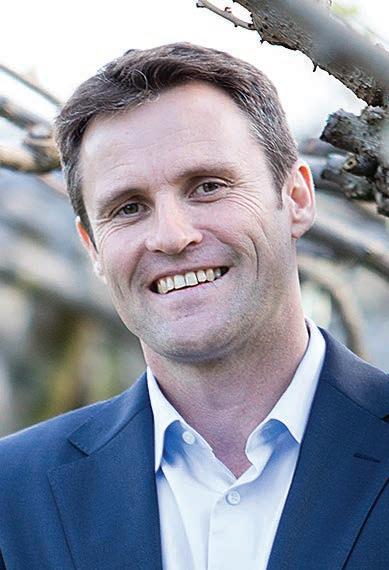
Over 100 people are employed in five regional offices in that country.
With new sustainably produced packaging, more than 40% of kiwifruit are bought online and delivered to the home.
Zespri has expanded from 60 to 90 cities over the past three years and now reaches 150 million potential customers.
Distribution can also be deepened as consumption increases from five fruit per person annually in Shanghai to 10 pieces in Taiwan.
Mathieson said the aim is to market high-quality healthy foods using new technology in e-commerce.
Not a recession as we know it in China
CHINA’S growth is slowing but its economy will still expand by US$1 trillion a year, ANZ Bank chief economist for Greater China, Raymond Yeung, says.
That expansion well exceeds the combination of ASEAN countries and India.
The slowdown of New Zealand exports to China is a cyclical pattern, not structural, and NZ is not being treated any differently to the rest of the world.
“China continues to stick to an open trade policy instead of protectionism,” Yeung told the annual China Business Summit in Auckland.
But the consumer price index is zero and China is one of the few countries in the world that does not have an inflation problem.
For historical reasons, older Chinese people save aggressively and pay down their mortgages to provide security for their children.
China continues to stick to an open trade policy instead of protectionism.
Raymond Yeung ANZ Bank
Household deposits equal three years of consumption.
“We have direct interests in these areas and are therefore focused on the need for tensions to be carefully managed and deescalated in the wider interests of the region.”
Agriculture and Trade Minister Damien O’Connor also spoke at the summit, saying that trade links with China proved remarkably resilient over the covid period.
“That was due in no small part to hard work by people in this room.
“To maintain access requires sustained, long-term efforts by NZ Trade & Enterprise and the Ministry for Foreign Affairs and Trade.”
Over the preceding weekend O’Connor had hosted ministers from countries in the Comprehensive and Progressive Agreement for Trans-Pacific Partnership.
Among them was Australian Associate Trade Minister Tim Ayres, who was also going to Wellington to mark 40 years of the Closer Economic Relationship between the trans-Tasman countries.
“Its trade policy is pragmatic, strategic and commercial.”



NZ will benefit from this commitment to free trade and its products are a perfect match for China’s food security policy.
Yeung spoke a few hours before the official release of the GDP data for the second quarter of 2023, which was 6.3% compared with the first quarter’s 4.5%.
Yeung highlighted the high youth unemployment rate as a result of a transition from low quality assembly jobs to higherskilled workforce requirements. An example is China’s production of electric vehicles, which now account for 70% of all vehicles made, up from only 10% five years ago.
Until that youth employment improves, Yeung does not expect consumption to grow strongly.
10 FARMERS WEEKLY – farmersweekly.co.nz – July 24, 2023 News 10
Hugh Stringleman MARKETS Exports
Hugh Stringleman MARKETS Exports
Hugh Stringleman MARKETS Exports
STAFFING UP: Zespri chief executive Dan Mathieson told the China Business Summit that the single-desk exporter now employs more than 100 people in China.
Miles Hurrell Fonterra
DIPLOMACY: Prime Minister Chris Hipkins spoke on the strong trade ties with China after his recent post-covid mission to that country.
New Zealand will always be consistent, predictable and respectful in addressing our differences with China.
BEEF: New Zealand’s products are a perfect match for China’s food security policy.
Poor weather drives down maize yields
Gerald Piddock MARKETS Crops
THE latest Arable Industry Marketing Initiative survey of maize growers shows that the extremely wet growing season has impacted yields for both maize silage and maize grain.
Wet soil conditions from frequent rain delayed drilling and some crops were flooded and had to be re-drilled.
“Above average rainfall occurred throughout the growing season across New Zealand. A tropical cyclone in February brought heavy rain and winds, which flooded and flattened many crops and delayed harvest of grain crops in many North Island regions,” the report says.
“In some areas, particularly the eastern region between Napier and Gisborne, entire crops have been wiped out.”


The data from 87 farms across New Zealand as of June 1 this year shows an average yield of maize grain at 9.7 t/ha (including estimates for the crops yet to be harvested) – which is down on last season’s average of 11.5 t/ha.
99.7% complete as of June 1. The estimated total tonnage of 1,051,600t DM was down 7% compared to last season’s harvest, as the result of 9% lower yield from a 3% increased harvest area.
About 65% of the total silage crop had been sold or used, leaving 363,100t DM unused/unsold as at June 1, as compared to 390,200t DM at the same time last year.
Spring 2023 sowing intentions as of June 1 are similar to last season’s – down 3%.
Calving 2023
Arable Industry Marketing Initiative report

The average yield of maize silage, 19t dry matter (DM)/ha) is also down on last season (at 20.9t DM/ha).
The maize grain harvest was 63% complete as at June 1, which was less than normal, with the 10-year average being 79% complete at this time.
Some of the unharvested area may not be harvestable due to continued wet weather, which means New Zealand tonnages could be overestimates, the report says.
The estimated total tonnage of 164,400t (including unharvested grain) is down 13% on last season’s harvest tonnage as a result of 16% reduced yield from 4% increased harvest area.
Around 89.8% of the total crop had been sold, leaving 16,700t unsold, as held by growers as of June 1, though most of the unsold tonnage was unharvested at this date.
This compared to 5600t unsold at the same time last year, and higher unsold tonnages at the same time in five of the eight previous years.
Spring 2023 sowing intentions were estimated to be 12% lower than last season.
The New Zealand maize silage harvest was
Support lifetime traceability
• Ensure all calves are fitted with a NAIT tag before they reach 180 days of age.
• Register any fitted NAIT tags within 7 days of tagging.
• All calves must be tagged and registered before their first movement. So, if you are sending them off your location, make sure you meet your NAIT obligations.
• Calves must be NAIT tagged correctly.
For more information go to
NAIT is an OSPRI programme Failure to comply with NAIT obligations may result in fines or prosecution issued by the Ministry for Primary Industries. For more information about your obligations as a PICA, please visit our website ospri.co.nz.
Google the publica-
OSPRI.co.nz or 0800 842 463
11 FARMERS WEEKLY – farmersweekly.co.nz – July 24, 2023 News 11
TOO WET: Some of the unharvested area may not be harvestable due to continued wet weather, which means New Zealand tonnages could be overestimates, the report says.
In some areas, particularly the eastern region between Napier and Gisborne, entire crops have been wiped out.
Subscribe on YouTube
You’re walking a paddock, thinking about today’s tasks, or planning for the season ahead. What’s on your mind may be new cropping or pasture options, updating your animal health plan, how to add five percent to your weaning weights, or what feed supplements to choose.


































A fresh perspective.



Whether it’s about bouncing ideas, seeking technical advice, or looking after crops through the season, that’s where your local Rural Supplies Representative comes in. Our representatives bring a fresh perspective and whole farm understanding to the table and can help take the load off.
Science leaders call for NZ food strategy











THE directors of six National Science Challenges have called on the government to develop a National Food Strategy for New Zealand.














“Food is essential to our health and wellbeing but it can be a major cause of ill-health and disease,” said Professor Sir Jim Mann, director of the Healthier Lives challenge.


“The food we produce also has profound effects on the environment and on climate change, and is vitally important to our economy. A healthy and environmentally sustainable food supply is essential for human and planetary health.”
As the National Science Challenges enter their final year, the six science leaders declared their intention to bring key findings from their research together to support a future National Food Strategy.
A strategic, scienceinformed plan is needed to both reduce food production’s contribution to climate change, and adapt to future challenges.
“Land-use change in Aotearoa is unavoidable under a changing climate and in response to policy for freshwater protection. It makes sense to take a strategic, planned approach to redesign future food production in New Zealand in a way that has significant co-benefits for our people and our environment,” said Dr Jenny Webster-Brown, director of Our Land and Water.
Research by Healthier Lives has shown that adopting a healthier diet can save lives and reduce

greenhouse gas emissions. Research by Our Land and Water has shown that it’s possible to change land use to produce the food needed for this healthier diet.
“A National Food Strategy should also recognise that food is a basic human right. We have too many people who don’t have enough nutritious food,” said Professor Cliona Ni Mhurchu, deputy director of Healthier Lives.
“At the moment we have school lunches going into some schools, and that’s a great initiative – but who’s looking at why our elderly are hungry? There needs to be a much wider perspective,” Joanne Todd, director of the High-Value Nutrition challenge, said.
The science leaders point to the decline of NZ’s scallop fisheries as an example of the need for an integrated, mountainsto-sea approach. Erosion from land-based agriculture affects shellfish species, but land management regulations and climate change policy are currently disconnected from this impact.
“Sediments from forestry and agriculture are not great for scallops, which are filter feeders, and there’s also pressure from fishing, both commercial and recreational,” said Dr Julie Hall, director of Sustainable Seas.




“You’ve got to change land practices, as well as fishing practices.”











































































































































































































































































































































































































































































































































































































































































Climate change policy can also be disconnected from its wider food system impacts.
“A strategic approach would help policies work together. For example, the forests we establish to fight climate change should complement our sustainable food systems,



not destroy them,” said Dr Phil Wiles, director of the Deep South challenge.
















The directors agreed that a National Food Strategy can offer clarity on NZ’s goals as a food producer and guardian of its population. As such, it should be codesigned by community, industry and government, and supported by science and mātauranga Māori.

“A food strategy can help us set the national priorities together: what do we really care about as a country –for nutrition, environment, equality, and climate resilience?” Wiles said.
“Food covers so much of what we do – our health, our economy, our environment,” said Todd.

“Food crosses a huge amount of our legislation, but these laws are not connected at present. If they were, we could encourage activities that are sustainable, resilient to climate change, minimise waste, and have positive impacts on society and culture,” Hall said.
The National Science Challenges were established to build bodies of knowledge in areas of science considered critical to the future of NZ.
The six directors represent research across a broad range of food system issues, including improving nutrition and equitably reducing dietrelated diseases, adapting food production to climate change, reducing foodaccess inequality and reducing the impact of food production on land and at sea.















This cross-National Science Challenge initiative is an outcome of the Feeding Aotearoa panel discussion at the recent NZ International Science Festival.





A an Carlene Sarah Swinbourne 20-09 Working alongside you, every season of the year. Find your rep, go online to store.pggwrightson.co.nz
12 News 12
SOUND BITES: Niki Bezzant facilitates the Feeding Aotearoa panel discussion at the New Zealand International Science Festival with, from left, Professor Cliona Ni Mhurchu, deputy director of Healthier Lives; Joanne Todd, director of High-Value Nutrition; Dr Jenny Webster-Brown, director of Our Land and Water; Dr Julie Hall, director of Sustainable Seas; and Dr Phil Wiles, director of Deep South.
Staff reporter NEWS Food and fibre
Wonky fruit and veg supply catches on
ANGUS Simms and Katie Jackson are on a mission to find homes for New Zealand’s ugly and unloved fruit and vegetables.
Two years ago the couple established Wonky Box, a fruit and vegetable home delivery service out of Wellington, and initially ran it from a converted camper van. The aim was to buy growers’ fruit and vegetables that didn’t meet export or supermarket standards, package it in boxes of mixed produce and sell it to consumers.
With tough economic times and rising fruit and vegetable prices, the concept has captured the public’s imagination.
“Consumers aren’t necessarily that fussed about the shape, the size or how ugly it is,” Simms said.
“The standard consumers are expecting is a lot lower than supermarkets or the exporters in New Zealand have put in place. As long as it’s fresh it still has the same nutritional value and taste as a perfectly formed piece of fruit would.”
Interest has been such that Simms and Jackson recently moved to Auckland to oversee a second distribution centre alongside the Wellington base. The company delivers thousands of boxes each week throughout the North Island via NZ Post. What began as a two-person operation now employs 40 staff.
“We picked up pretty quickly that to ensure we are getting the freshest produce out the door to our customers we couldn’t just run from one distribution centre,” Simms said.
Since starting in 2021, Wonky Box has now rescued more than 100,000kg of produce, which would
have otherwise gone to waste. It has also provided an extra revenue stream for growers.

The couple met in the United Kingdom, while Simms was on his OE. Jackson is British and worked for the UK’s NHS as a psychiatric nurse.
The idea for the business began after the pair returned to Simms’ home town, Wellington, in 2021. They bought a camper van and hit the road, working in orchards to fund their travels.

While employed at a South Island orchard they experienced a severe hailstorm that ruined much of the fruit.
“We were discussing how the growers lost so much produce overnight. Some of it was still in very good nick, but not up to the cosmetic standards for export, so they didn’t even bother asking us to pick it,” Simms said.
From that conversation, it was back to Wellington for some research and eventually Wonky Box was born.
Jackson wasn’t surprised by the public interest in Wonky Box as it was soon apparent they were addressing a gap in the market.
“There was a such a lack of options with regards to delivery of fruit and veggie boxes that focused on the sustainability and food waste aspect, while also addressing the cost of living,” she said.
According to the Ministry for the Environment, a third of all produced food is wasted each year globally and around 4% of New Zealand’s total greenhouse gas emissions are from food and organic waste.
Wonky Box’s fruit and vegetables were initially sourced from Horowhenua growers, although some took convincing to be involved.
Simms said the first six months involved a lot of “hustling” as they tried to get growers onside.

“It doesn’t matter how big or ugly the produce is, it costs the same to pull it from the ground as

a perfect quality bit of produce.
Figuring out the pricing and making it work for the growers was a learning curve.”
Word spread and the company now sources produce throughout New Zealand. The couple are keen to use even more growers.
“A lot more growers are coming to us now saying what they might have available each week. We would have two to three reach out to us on a weekly basis.

“What they have realised is that by working with a business like Wonky Box they can potentially move a lot more product than they typically might.”
The content of the boxes varies weekly, depending on the seasonal availability of fruit and vegetables. Boxes traditionally include 10 varieties of produce – staples such as kūmara, potatoes, onions and carrots, greens and fruit.
“It’s important to put variety in the box for our consumers’ sake but we’re also trying to meet what is available from our growers,” said Simms.
As for long term plans for the business, Jackson said they would like to get more growers on board and eventually offer deliveries in the South Island.
“We want to be at the forefront of growers’ minds when they have got produce that they cannot move because of the criteria set out by the main markets,” Jackson said.
“We want to support more growers across the country, be the lead in reducing food waste and support Kiwi households to ensure they are eating healthily, eating well and at affordable prices.”
... is online now! Study Ag&Ed and you’ll discover the wealth of career opportunities in the food and fibre sector. Go to: agrihq.co.nz/our-education-resources Or scan the barcode Growers – Growing together OPPORTUNITIES FOR ALL LK0116157© 13 FARMERS WEEKLY – farmersweekly.co.nz – July 24, 2023 News 13
Craig Page NEWS
Food and fibre
EXPANDING: Wonky Box’s Angus Simms and Katie Jackson have recently moved to Auckland to oversee a second distribution centre alongside the Wellington base.
Consumers aren’t necessarily that fussed about the shape, the size or how ugly it is.
Angus Simms Wonky Box
HELPING OUT: Angus Simms and Katie Jackson want their company to lead the way in reducing food waste and support Kiwi households through food affordability.
Letters of the week
There’s value in being GE free
 Jon Carapiet Auckland
Jon Carapiet Auckland
NOW that Britain has joined the Comprehensive and Progressive Agreement for Trans-Pacific Partnership trade deal, New Zealand producers and exporters must ensure we maintain our world class standards for food safety and traceability.
The history of food scares in the United Kingdom is much graver than in NZ, and they have driven many consumers to want to know where products come from and how products are made.
This remains the case for products of gene editing, with 80% of people wanting safety regulation and labelling of food produced from new breeding techniques.
Unfortunately the UK government disagrees.
The National Party’s proposal to exempt some gene-edited products from regulation and labelling goes against what most consumers want: the right to choose.
Traceability of new gene-edited organisms is in the best interests of NZ farmers and the export sector.
From the Editor
Not the biggest role but still a
Bryan Gibson Managing editor

MAIN character syndrome, a term coined on social media, is when a person acts like they’re the protagonist of the events that unfold around them.
It’s a natural thing to think and we all do it a bit.
But it’s a belief that can lead to other worrisome traits – hubris being one.
Take the issue of leakage when we discuss food production and emissions.
Many in our industry rightly state we’re at or near the top of the pile when it comes to emissions efficiency.
If we cut production, it’ll be taken up by less efficient producers, they say.
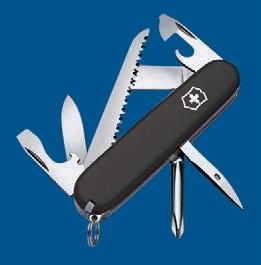
New Zealand produces a bit over 750,000t of beef a year.
If 20% of that production were to be cut, it’d be terrible for our farmers and our economy, but emissions would barely waver.
The European Union, Australia and the United States all have similar or only slightly worse emissions profiles than NZ, and the US alone could fill that 20% by redirecting just 5% of the beef it exports.
And while NZ is well placed right now on the carbon efficiency ladder, it won’t be for long.
California, for example, has legislated a 40% reduction in biogenic methane from 2013 levels and is on track to achieve that.
Now, we’re not all that taken with California’s way of raising beef cattle in feedlots and barns, but that system provides methane reduction opportunities that our pasture-based system does not.
Farmers there are using anaerobic digesters and feed additives to meet the new requirements, tools that are difficult to migrate to the green grass of New Zealand.

Big processors are also implementing programmes to reduce emissions.
Cargill, for instance, has its Reach for Reduction strategy that takes a holistic view of the challenge, with a blueprint for farmers that incorporates on-farm productivity management, feed and nutrition, and innovations in feed additives.

NZ’s new Agricultural Greenhouse Gas Research Centre, a partnership that includes the government and many of the key processors, is looking into tools that will work here and hopefully we now have the funding and intent required to move the dial.

We’re going to have to if we want to keep pace with what’s happening elsewhere.
Other parts of our food supply chain are changing with the times as well.
Last week’s announcement that six of Fonterra’s plants will undergo upgrades to transition away from coal use, taking care of 2.69% of the cuts the nation needs to make to meet its targets, is another giant step on the journey.
Whatever the pros and cons of the push to deregulate biotechnology, we have a marketing advantage in maintaining our standards. For consumers this is especially true.
The National Party must change its policy to ensure regulation and labelling of geneedited products. It is a point of difference that consumers value and can help us be more than just commodity suppliers.
The premium value of GE-free production must not be underestimated. Rabobank forecasts Australian national non-GM canola prices to average between $560/t and $670/t over the coming year. GM canola varieties are expected to trade at a $20/t to $50/t discount compared with non-GMO.
There’s much to be hopeful about – so there’s surely little need for our sector to stubbornly point to what we’ve done in the past and blame other food producing nations for lagging behind.
We rightly take pride in our ability to help feed healthy and sustainable food to the world.
But our place in that system is small, and our advantage lies in being very good, not very big.
In today’s world that means being sustainable now and pledging to be more so in the future.
14 Editorial
a
knife Send your letter to the Editor at Farmers Weekly P.0. Box 529, Feilding or email us at farmers.weekly@agrihq.co.nz FARMERS WEEKLY – farmersweekly.co.nz – July 24, 2023 Opinion 14
Best letter WINS
quality hiking
Our place in the system is
and our advantage lies in
big. Delivered to the farm gate of more than 24,000 Kiwi dairy farmers every month Advertise with us Call 0800 85 25 80
key one
small,
being very good, not very
A promise to lead from the front on trade
Chris Hipkins



Prime Minister
IN THE six months I’ve been prime minister, I’ve put enhancing trade front and centre of my priorities. That’s because the success of our export sector means success for the whole country.
Furthering our Closer Economic Relationship with Australia, bringing the United Kingdom Free Trade Agreement into force, and signing the European Union FTA have been central to my own international travel. Gaining better access to more of our products is a key part of our plan to grow the economy.
Our government has delivered some of the best progress on international trade agreements of any New Zealand government. The proportion of our total exports covered by Free Trade Agreements has expanded from 52.5% in 2017 to an estimated 73.5% once the recently signed EU agreement comes into force.
That means strengthening and deepening our existing trade relationships too, and the recent trade delegation I led to China showcased the kind of progress we can make when business and government work together on the global stage.
There’s no doubt that a visit from a New Zealand prime minister helps to open doors for our exporters, and I was pleased to witness a number of new agreements that will help to increase our exports across a diverse range of goods and
services, from kiwifruit to pet food to personal health and wellbeing services.
And it’s paying off. Visiting China with a delegation of some of our best businesses built connections and opened doors. That’ll mean more opportunities for trade in the coming years as the growth in China’s middle-income earners accelerates.
It always gives me a great buzz to see quality Kiwi products from our primary sector on supermarket shelves overseas, and we saw plenty of Kiwi businesses thriving in the huge China market.
Our recently active NZ-UK FTA gives our dairy and red meat sectors significantly improved access to the UK market for the first time in nearly 50 years. And our Europe visit locked in a free trade deal worth around $1.8 billion a year.
Last week, under our chairmanship, we welcomed the UK into the CPTPP family. The Comprehensive and Progressive Agreement for Trans-Pacific Partnership is worth $60bn in two-way trade with partner economies, and provides significant benefits and opportunities for our exporters. Adding the UK will only see those economic opportunities for growth and recovery further increase.
Figures like those are precisely what’s needed to drive our economy’s recovery, and are a key part of my economic plan. They’re a good start, but there’s more we can do as a government to drive
trade growth as well as insulate ourselves from emerging risks.
We all know that our clean, green sustainable reputation is important in supporting the value of our exports. Whenever I talk with our trading partners, I’m struck by the remarkable rise in overseas consumer concern around climate and sustainability.
In conversations with wine buyers who service London’s major restaurants, for example, what they increasingly want from us is a strong and authentic back story. The sustainability and unique cultural stories that underpin our wines set them apart. It’s the same for our other food products.
That’s why we need to keep up the momentum when it comes to
We’re an exporting nation, and I know how important it is for the government to pull out all the stops to secure access to international markets.
primary exporters and everyone who has shouldered the burden of those challenging events. The government is committed to that. We want to bounce back stronger than ever and, working together, I know we can do just that.
I’ve always believed that if you work hard, you should be able to get ahead and create a better life for yourself and your family. That’s why I’ve been so focused on creating the economic conditions that generate good, well-paid jobs that help to unlock opportunities for Kiwis.
We’re an exporting nation, and I know how important it is for the government to pull out all the stops to secure access to international markets. Success for our export sector means success for the whole country.
tackling climate change. As the rest of the world forges ahead, New Zealand can’t afford to lag behind.
If we get it right, we’ll be able to command higher prices and grow our market share. If we get it wrong, the risk is potentially disastrous damage to our international brand – with real economic consequences.
It’s a complex issue and I certainly won’t claim perfection on the government’s part.
Ongoing dialogue and partnership are the best way for us to make progress.
I know the sector is feeling the pain of the global and weather challenges of the past three or so years. We have a responsibility as a country to support our
My commitment is to lead from the front on trade. I’ve promised to lead at least two trade delegations a year to existing and emerging markets to maintain the momentum for as long as I have the privilege of being prime minister.
Farmers Weekly connects our community Growers, growing together
Oh yes. I always read it. It’s a must. Good articles. I read the whole thing.
It’s part of the classroom activity. We encourage them to get amongst it and have a read and see what’s going on. We always push them to read it. Me personally? It’s good. The market stuff - I flick straight to that to be honest. It gives you an idea of what’s happening around the stock and store markets. It’s a good format.
Rob Evans Station Manager, Smedley Station cadet training farm, Hawkes Bay.

Growing food, fibre, knowledge, people and connections – together.

Guy Bell
Sixth generation Hawke’s Bay sheep and beef farmer, Waipawa.
LK0116158© 15 In My View
In my view ...
a view on some aspect of farming you would like to get across? We offer readers the chance to have their say. Contact us and have yours.
Phone 06 323 1519 FARMERS WEEKLY – farmersweekly.co.nz – July 24, 2023 Opinion 15
Got
farmers.weekly@agrihq.co.nz
DELEGATIONS: Prime Minister Chris Hipkins undertakes ‘to lead at least two trade delegations a year ... for as long as I have the privilege of being prime minister’.
Our position on trade is just plain crazy
Alternative view
It’s the fault of successive governments, as Australia has established universities in India and opened Indian immigration. We have done neither.
We are a trading nation and we do that well. We are part of the Comprehensive and Progressive Agreement for Trans-Pacific Partnership CPTPP, we have the FTA with the United Kingdom that’s just come into force, we have a strong market in China and we now have an FTA with the EU.
Alan Emerson Semi-retired Wairarapa farmer and businessman: dath.emerson@gmail.com

THE recent Free Trade Agreement between New Zealand and the European Union is massive. It will eventually be worth $1.8 billion a year, and duties will be removed from many of our exports there from day one. In addition we have new access quotas for beef, sheepmeat, butter and cheese.
The EU farmers claim their negotiators gave away far too much and our farmers wanted more. Such is the nature of trade agreements.
Of interest is that Australian farmers have told the government that if the deal isn’t right, they should just “walk away”. I hope they do. The next challenge for an FTA is with India.
Almost 40 years ago then prime minister David Lange hosted a trade delegation to India. Not much has happened since. Australia has an agreement with India.
The world economy is changing and our focus needs to change with that. Those countries moving up the GDP ladder include India, Indonesia, Nigeria, the Philippines and Vietnam. Conversely, those losing their positions include many of our traditional markets, the United States, Japan, the UK and Australia.
Non-tariff barriers have been a fact of life for decades and appear to be decided more by domestic pressures than any degree of logic.
An upcoming non-tariff barrier, we are told, will be carbon footprint.
For example, the New Zealand EU FTA has each holding the other to account for their commitments under the Paris Agreement.
I view that with a strong degree of cynicism.
Mark de Lautour is the chief executive of Open Country. He was previously with AFFCO. He is regularly involved with selling NZ’s primary produce, including wood products, seafood, beef and lamb and now dairy on the international marketplace.
Asked about the requirement that we reduce our GHG footprint to meet the demands of the international marketplace, he is forthright.
“To date we have had no restrictions,” he told me. “The key issue is that no consumer is currently prepared to pay a premium for product with a reduced carbon footprint. There continues to be a lot of media hype and large corporations making statements about carbon reduction but nobody has answered the important ‘who is going to pay’ question.
What a cop-out. It appears we can insist on labour rights, the rights of indigenous people and gender equity, but not animal welfare.
“There is little doubt in my mind that in the short term the issue will fall into the too-hard basket and carbon reduction timeframes will be stretched. It will be impossible to enforce when food supply and cost will create bigger challenges.
“For example, large European supermarkets will struggle to limit supply from New Zealand as our
carbon footprint is already a lot lower than that of local produce, even considering freight.
“Scarcity is the only true driver of sustainable value. Our approach at Open Country Dairy will be to focus on doing what is right rather than public box-ticking.
“As New Zealanders our approach should be to collectively maintain our position as the best supplier of food in the world, be that based on quality, food safety or carbon footprint.

“By doing that we will create scarcity that will drive value. Let’s not fret about being locked out of markets.”
I totally agree.
I went onto the Ministry of Foreign Affairs and Trade website, which filled me with horror. Their Trade for All principles are outrageous.
For a start, they want consultation with Māori. Why? What will that achieve?
That’s followed by labour rights, gender equity and the rights of indigenous people. Poverty reduction and sustainable job creation are in there as well. Again, why?
We’ve recently had the
United Arab Emirates in NZ attempting to negotiate a trade agreement. Stupidly, in my view, NZ introduced labour and environmental standards into the negotiations.
The UAE response: “The minute we bring politics into discussions we are diluting the main objective of the agreement,” their trade minister said.
I agree. Our position is just plain crazy.
It gets worse with Parliament’s Primary Production Committee refusing to insist imported pork has the same animal welfare standards that we do. Their reasoning is that “they would be contrary to NZ’s international obligations”.
What a cop-out. It appears we can insist on labour rights, the rights of indigenous people and gender equity, but not animal welfare.
A final thought. With Ireland drastically cutting cow numbers, the Dutch disembowelling their dairy industry and an increasingly harsh war in Ukraine, where’s the food going to come from?
We should be concentrating on free trade and not own goals.
On cusp of next step up in climate crisis
Guest column
Kevin Trenberth
Distinguished Scholar, National Center of Atmospheric Research; affiliate faculty, University of Auckland
GLOBAL warming took off in the mid-1970s when the rise in global mean surface temperature exceeded natural variability. Every decade after the 1960s has been warmer than the one before and the 2010s were the warmest on record. But there can be a lot of variability from one year to the next.
Now, in 2023, all kinds of records are being broken. The highest daily temperatures ever recorded globally occurred in early July,
alongside the largest sea surface temperature anomaly ever.
June had its highest global mean surface temperature, according to preliminary analysis. The extent of Antarctica’s sea ice has been at a record low. Meanwhile, atmospheric carbon dioxide concentrations continue to increase at rates that show no sign of slowing.
Evident consequences include torrential downpours in some parts of the world, which contrast with excessive heatwaves and wildfires in other locations, notably recently in Canada. But global mean surface temperature does not continue relentlessly upwards.
The biggest increases, and warmest years, tend to happen in the latter stages of an El Niño event.
Human-induced climate change is relentless and largely predictable.
But at any time, and especially locally, it can be masked by weather events and natural variability on interannual (El Niño) or decadal time scales.
The combination of decadal variability and the warming trend from rising greenhouse gas emissions makes the temperature record look more like a rising staircase, rather than a steady climb.
Atmospheric carbon dioxide concentrations continue to climb relentlessly upwards despite the Paris Agreement and the many countries and organisations (cities, companies) that have made good on their commitments to cut emissions.
Unfortunately for the planet,
some nations, including China and India, have continued to burn coal and install coal-fired power stations, whose emissions more than offset gains elsewhere.
During
But the rise in temperature follows a step-like progression. The warmest year in the 20th century was 1998, following the 1997-98 major El Niño. Then the warming paused and the so-called “hiatus” in global warming from
2001 to 2014 led climate change deniers to become vociferous in proclaiming global warming was a myth.
The major El Niño event in 201516 changed that. The year 2015 became the warmest on record, ending the hiatus, only to be surpassed by 2016, which remains the warmest calendar year so far in many records.
A lot of year-to-year variability is associated with El Niño events. But it is more than that. Further analysis reveals that the Pacific decadal variability, sometimes referred to as the Pacific Decadal Oscillation or Inter-decadal Pacific Oscillation, resulted in changes in the amount of heat sequestered at various ocean depths.
The Pacific Decadal Oscillation
16 Opinion FARMERS WEEKLY – farmersweekly.co.nz – July 24, 2023 Opinion 16
STANDARDS: Open Country CEO Mark de Lautour says his company’s approach when it comes to non-tariff conditions of trade is to ‘focus on doing what is right rather than public box-ticking’.
Continued next page
El Niño, heat stored at depth in the western tropical Pacific is moved around and returns to the atmosphere, providing a mini global warming.
A family sets out to change its farm
Eating the elephant
Three years ago, we decided to start to change that business model. We would still be beef farmers, but we’d become foresters, poultry-keepers, orchardists, bee-keepers and carbon sequesters too. We would try to let individual hills, flats and gullies tell us what production systems to lay on top of them.
To pay for all this, we would create our own farm brand and sell direct to customers – adding product marketers, social media content creators and supply chain managers to the new job description list too.
OUR farmhouse looks onto a hill. It’s steep, but gives way to a gentler roll at the bottom with some decent feed for our Angus herd.
I’ve spent dozens of hours, maybe hundreds, looking at that hill and getting angry. Like countless other hills around New Zealand, it is cut by cattle tracks. Slowly but surely, our animals have pressed and packed down the soil. One day the hill will slip. Then nothing but moss will grow there, clinging to the bedrock.
I don’t want to leave a hill like that to my daughter or nephew.
The cold fact is that our animals shouldn’t be on that hill, or the other 60% of our rolling-to-steep Kaipara farm. The other cold fact is that our beef-raising business survives on that marginal land.

It’s hard to acknowledge this, but we’re running a business model that is slowly eroding the natural productivity of our land.
may be thought of as a northern hemisphere version of the Interdecadal Pacific Oscillation.
With the Pacific Decadal Oscillation, there were major changes in Pacific trade winds, sea-level pressure, sea level, rainfall and storm locations throughout the Pacific and Pacificrim countries. These changes extended into the southern oceans and across the Arctic into the Atlantic.
The effects are greatest in winter in each hemisphere. There is good but incomplete evidence that changes in winds alter ocean currents, ocean convection and overturning, resulting in changes in the amount of heat sequestered deep in the ocean during the negative phase of the Pacific Decadal Oscillation.
Accordingly, during the positive phase of the Pacific Decadal Oscillation, more heat is deposited in the upper 300m of the ocean, where it can influence global temperatures.
During the negative phase, more heat is dumped below 300m, contributing to the overall
We would hire an ecological consultant. I describe his job as being the voice of the land and soil, always advocating for what this flat or that hill wants us to plant or run there for intergenerational productivity. This was a new perspective on our farm for us. Often it was hard to hear – because it made us feel guilty, dumb or overwhelmed by how much work was ahead.
It’s a few years in now, and we’re getting there. Marginal blocks are being retired, the first syntropic tree rows are in and the flats are slowly being resown with multispecies mixes.
Having some communications experience, business skills and off-farm capital in the family has helped a lot.
But the heart of my family’s farming story isn’t about ecology, diverse production, brands or business models. That’s just the outcome. Our story is actually about three people in our family, and how transformative change demands something from each of them.
My dad is a 68-year-old stockman. He’s worked with animals all his life. He primarily sees the farm as a grass-growing
warming of the oceans but lost to the surface.
During El Niño, heat stored at depth in the western tropical Pacific is moved around and returns to the atmosphere, providing a mini global warming. Research shows that ocean heat content increases more steadily than surface air warming and is a

engine that enables him to continuously improve the quality of our cattle.
Then there’s my sister and brother in-law. They chose to move to the farm from sales and marketing jobs in the city, put their shoulder to the wheel and do the hard graft to make the change happen.
They came in with no preconceptions about what the farm is or should do. They love the stock, but are also the driving force behind the syntropic tree rows, native restoration, honey and the farm brand.

The changes they are driving are
better metric to show that global warming continues.
Sea-level rise comes from both the expansion of the ocean as it warms and the melting of landbased ice (glaciers and ice sheets in Greenland and Antarctica). This puts more water into the oceans. Fluctuations occur as rainfall is partitioned differently between
sometimes hard for Dad. There is an argument over most new fence lines – him to keep more grass, them to retire into it some kind of forestry. He sees these new ideas about holistic farming, retiring land and diversifying production as a quiet threat to his beloved herd.
This push and pull between the forces of tradition and transformation can be tiring and painful at times. To keep working well together and the farm moving forward, the process constantly demands something from all involved.
From Dad, the change demands that he questions some long-held beliefs. Like taking seriously our concerns about a rapidly changing climate, or that the cattle tracks he has looked at for 20-plus years represent something wrong with the way we’re farming. That’s not easy.
From the newcomers, the
land and the ocean, with more rain on land during La Niña events.
The ocean covers 70% of Earth. Because most of it is in the southern hemisphere, which experiences winter in June to August, the highest values for sea-surface temperatures occur in March, at the end of southern summer. But as land temperature
change demands an openness to compromise on the speed and scale of the transformation, and a willingness to shut up and really listen sometimes. That’s also not easy.
In watching this messy process of change happening in our family and on our farm, I can’t help but see a wider food and fibre sector grappling with the same contest between tradition and transformation.
I think there are two lessons to take from my family’s story. First, our big change is only happening because of the drive, creativity and open-mindedness of new people. We simply wouldn’t be moving forward without them. Second, we’re lucky to have an existing leader who continues to give those new people support, time and resources to experiment and redefine the farm – even when he finds the new way hard to accept at times.
variations are much larger, the highest global mean surface temperatures occur about July.
With a new El Niño emerging and prospects that it could be another major event, are we about to experience the next step up the stairs? Already in 2023, seasurface temperatures emerged in April as the highest on record and values are running 0.2degC above previous highs.
This set the stage for June to have record high surface air temperatures globally. In early July, they hit the highest values on record.
We can expect 2023 to emerge as the warmest year to date. But sea-surface temperatures during El Niño events tend to peak about December and have the greatest influences in the subsequent two months. That sets the stage for 2024 jumping up the staircase to the next level, perhaps to 1.4degC above pre-industrial levels, with likely daily incursions over 1.5degC.
Once the next La Niña event comes along, there’ll again be a pause in the rise, but values will never quite go back to previous levels.
17 FARMERS WEEKLY – farmersweekly.co.nz – July 24, 2023 Opinion 17
Daniel Eb
Daniel Eb helps Kiwis connect with farming through his agency Dirt Road Comms and Open Farms. His family farms in Kaipara. eating.the.elephant.nz@gmail.com
LISTEN TO THE LAND: ‘Three years ago,’ says Daniel Eb, ‘we decided ... we would try to let individual hills, flats and gullies tell us what production systems to lay on top of them.’
This push and pull between the forces of tradition and transformation can be tiring and painful at times.
Continued from previous page
HOTTER SEA: In 2023, sea-surface temperatures emerged in April as the highest on record and values are running 0.2degC above previous highs.
A lifetime of fighting for the land
For an environmentalist, the opportunity to implement desired policies doesn’t get any better than being minister of conservation and land information. That was the opportunity offered to Eugenie Sage, who is retiring at this general election. She talks to Neal Wallace
THE list was long and Eugenie Sage concedes she was not able to tick everything off.
As a cabinet minister of both lands and conservation, she was able to introduce new policy in areas in which she was a long-time active environmentalist, including the South Island high country.
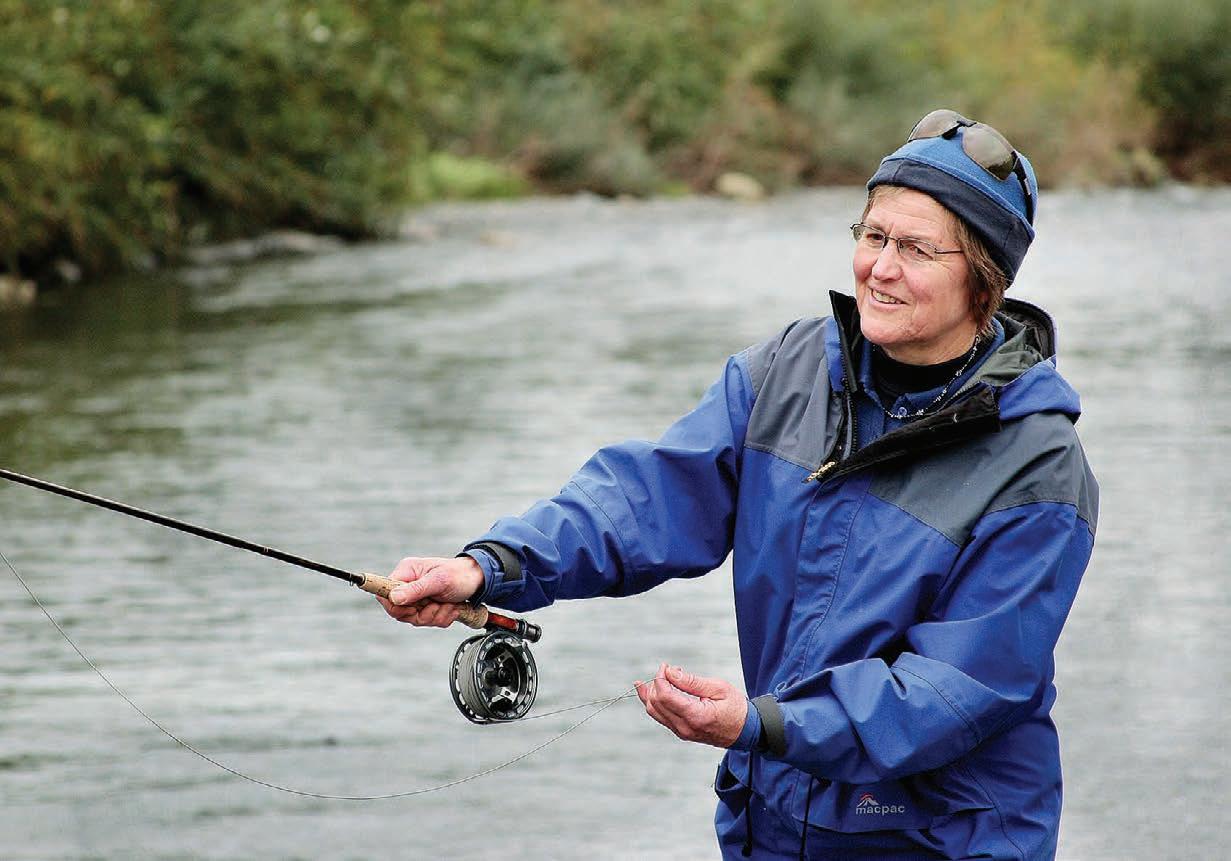
Sage is retiring at the October election, having spent three terms as a Green Party list Member of Parliament after being first elected in 2011.
Following the 2017 election, when the Greens were part of the Labour-led coalition, Sage was appointed minister of conservation and of land information.
As conservation minister she pushed through a biodiversity strategy that she had been involved with since the 1990s when it was first mooted, and also the controversial cull of Himalayan tahr, which was eventually scaled down.
As lands minister she completely reformed the relationship between pastoral lessees and the Crown, which included ending tenure review, where farmers could freehold part of their pastoral lease for retiring land of conservation value.
She says this will see conservation values enhanced through regulation rather than the government buying land off lessees through the tenure review process.
Her approach to these portfolios is hardly surprising given her background, which includes time as a field officer for Royal Forest and Bird and an Environment Canterbury regional councillor.
During that stage of her career, she advocated for greater protection for the environment and biodiversity, especially in waterways and the high country.
Born and raised in Auckland, Sage spent her childhood playing in adjacent gullies and holidaying on a relative’s farm.
“It was a free-range childhood, an opportunity for kids to connect with nature,” she says.
At Auckland University she studied law, art and journalism, and cut her teeth as a environmental activist, protesting against the opening of New Zealand’s first McDonald’s fast food restaurant and the replacement of milk bottles by Tetra Paks.
“I was concerned about fast food and litter and the very corporate model. With Tetra Pak, it was the move away from reusable bottles.”
That commitment to environmental activism was enhanced with a short-term role with the NZ Forest Service on the West Coast, where Sage wrote articles for the media and took guided bush walks.
At that stage rimu trees were still being harvested on the coast
and Sage recalls being traumatised when visiting a recently logged area near Okarito in Westland, something that would influence the direction of her career.
“It was a scene of devastation,” she says.
In 1985 she worked in the Labour Party’s Research Unit and then as press secretary to Helen Clark, who was then conservation minister in the David Lange-led Labour Government.
Soon after, Sage shifted to a field office role with Forest and Bird in Christchurch, where she worked for 13 years.
Parliament reinforced her view that NZ needs a “substantial reduction in animal agriculture”, especially dairying, saying it has especially impacted Canterbury freshwater resources.

She sees a future with more horticulture and niche industries like hemp and merino fabric.
As lands minister from 20172020, Sage oversaw the passage of the Crown Pastoral Lands Act (CPLA), which imposed tighter controls on what pastoral lessees can do on their farms, driven, she says, by trying to reverse what she calls a biodiversity crisis.
She makes no excuse for the CPLA, which pastoral lessees claim is overly punitive.
“There has been a huge loss of biodiversity in the high country through burning and cultivation, so we need a strong regulatory framework.
“There has been private commercial gain from the conversion of shrub land to clover and pasture at a cost to biodiversity.
One of the projects she actively campaigned in was ending native logging on the West Coast, which was ultimately successful.
That work also introduced Sage to issues in the South Island high country, and she submitted on consents from farmers seeking to go through tenure review or to develop their land.
In 2007 she was elected to ECan but lost that role in 2010 when the government replaced elected officials with commissioners due to issues with the council’s performance.
That work enhanced her interest in biodiversity and environmental stewardship of waterways and the high country.
That time on council and in
“There is no point having laws if you don’t enforce them.”
The Act requires farmers to seek permission for more activities such as weed control and soil disturbance from their landlord, the Commissioner of Crown Lands, and requires Land information NZ (LINZ) staff to inspect pastoral leases more regularly.
Consideration of farmer applications now include input from iwi, an additional step some farmers fear could slow the process unless there is a legislated time frame by which views have to be lodged.
Sage says it is appropriate Ngāi Tahu has input given the cultural significance of the land.
She does not think this will lead to delays, saying Ngāi Tahu has
systems in place for considering and responding to such applications.
After initial resistance to the CPLA, Sage says, there has been less pushback and she hopes it will encourage more assessment and understanding of ecological values.
She also hopes the Act will foster an improved relationship between lessees and LINZ, saying functions such as farm inspections were previously contracted out, making
it a bureaucratic exercise.
“That relationship is critical and needs to be a partnership.”
She acknowledges farmers feel their efforts to protect and enhance the environment is not fully acknowledged.
But pastoral “rents are low” and she says lessees have benefited from the current model, so it is appropriate the focus shifts to biodiversity and the environment.
The end to tenure review was crucial to achieve that.
Instead of the government acquiring land for the conservation estate through tenure review, Sage says, regulations will provide a high level of protection.
“I hope those in the high country increasingly recognise the importance of landscape and habitats.”
Whether the CPLA has met its goals is still to be assessed, but it is an example of the benefits of having the same person responsible for both conservation and lands.
She did not achieve all of her goals in areas such as tighter fisheries regulation, adding new marine conservation areas and protecting native fish such as Hector’s dolphin.
As she contemplates retirement, Sage, who is “in my sixties”is looking forward to once again tramping in the back country and body surfing.
But even in retirement, she cannot see herself closing the door on a lifetime of environmental activism.
18 People FARMERS WEEKLY – farmersweekly.co.nz – July 24, 2023 People 18
There has been a huge loss of biodiversity in the high country through burning and cultivation, so we need a strong regulatory framework.
Eugenie Sage Retiring minister of conservation, land information
OPEN AIR: Eugenie Sage says she had a “free-range childhood” which enabled her to connect with nature.
RETIRING: Eugenie Sage is retiring from politics but not environmental activism.
Apps helping to lighten the load for farmers
Neal Wallace TECHNOLOGY Software
STU Russell was in Invercargill when the alert came.
The Ashburton dairy farmer was at the South Island Dairy Event (SIDE) when a message on his smartphone told him that a newly purchased heifer from the North Island had started calving, well before of the rest of his herd.
She was with a herd being wintered on kale but the alert via a telephone app allowed staff to quickly move her onto pasture.
“It’s real-time data, it’s easy to get the phone out and check,” he told a session at SIDE on the use of smartphone apps.
Three farmers spoke about how phone apps assist with the running of their farms.

The smaXtec app that notified Russell his heifer was about to calf is linked to a bolus in a cow’s rumen and sends alerts about activities such as coming on heat or giving birth.
His other go-to is FieldNET, an app that assists with the monitoring of irrigation by merging information on weather, soil moisture through soil probes, pump performance,
allowing operators to adjust water application rates.
Having the information arrive on his telephone makes it easy to monitor performance and make immediate changes.
Southland dairy farmer
Tracy Henderson said she and husband Steve use WhatsApp to communicate with their five fulltime and two part-time staff. She said the app allows them to post notices as diverse as observations about individual animals, infrastructure, the completion of jobs or general
We had an audit by OSPRI and we had all the information in one place. Pretty much any information you want recorded is there. I liken it to a large filing cabinet.
Tracy Henderson Southland
notices.
Having an observation or issue recorded on the app means the next person knows exactly what has happened or what needs to happen next.
“It’s an easy, one-stop place.”
The fact that communication
can be via video, voice or the written word caters for everyone’s strengths.
For example, keeping a record of an activity that is centralised in the system is as simple as taking a picture of a newly cleaned farm bike, acknowledging the arrival on farm of drench or chemicals or that a backing fence has been erected behind stock grazing winter crops, to prove compliance.
Another app Henderson uses is Resolution, which she describes as an e-diary of all the data and details of the farm.
It collates details about the farm, such as fertiliser application, maps of the farm or infrastructure.
For example, if there is a water leak, Resolution provides staff with a map of water lines, allowing them to track where the fault is and repair it.
Contractors coming on farm to do earthworks or other tasks can be added to the app so they know the positioning of water lines and other infrastructure.
It also makes time recording easy.
“It’s piece of mind having everything in one place.”
Being compatible with Lead with Pride and FarmIQ adds to the usefulness of Resolution, she said.
“We had an audit by OSPRI and we had all the information in one place.
“Pretty much any information you want recorded is there. I liken it to a large filing cabinet.”
Luke Templeton, who farms near Riverton, uses HALO farm’s effluent monitoring system and said it provides instant information and alerts by text of faults with water schemes and systems such as with their vat.

“It has saved us multiple times, for example the paddle not turning.”
Another app he uses is MINDA, which provides instant online information and monitoring of tag numbers, preventing a doubling up and simplifying the process.
The programme can be extended to include details on individual animals, and Templeton said this season he is adding body score information.
He said staff enjoy working with apps as they make their job easier and reduce the risk of error.
If you want staff to do more, he said, this gives them the tools and power to enable that.
He welcomes the ability to book space online with meat processors for bobby calves but would like it extended to cull cows.
Henderson said when considering an app, it needs to fit the team and the farm system. “We find the more you use it, the more you empower your staff and the more we get back.”
Vertical farm system going up Ashburton
multilevel trays in climate- and light-controlled cells.
AMECHANISED growing system with the potential to improve New Zealand’s food production security will be set up in Ashburton by the end of August with planting to commence early September.
The Ashburton system is a Landlogic initiative to showcase what a vertical food production system can do.
The Vertical Farm Systems (VFS) XA Series is a modular system designed for warehouse installation with plants grown in
The increasing unpredictability and frequency of severe weather events, along with the rising costs impacting traditional open-field farming, mean it’s more important than ever to consider innovative approaches to sustainable agriculture, Landlogic chief executive Alan Cottington said.
“Our food security is vulnerable when we rely on traditional farming methods or importing for leafy greens, which are a basic and healthy food essential.”
It will be the first opportunity for many NZ horticulturalists to see a full-sized VFS growing system in operation.
The fully automated vertical growing system offers an important alternative to producing commercial levels of leafy greens in the horticultural industry, where traditional outdoor growing systems have taken such a huge hit in recent floods and storms.
The system is heavily automated with computer-controlled feeding, watering and lighting, and sensors monitoring temperature, pH, EC and humidity levels. Loading, harvesting, recovery and re-use of the growing medium and reloading of the trays is also automated.
In agribusiness the commercial production of leafy greens, herbs or plant seedlings using multilevel growing systems is rapidly expanding around the world.

Cottington said NZ needs to get on board with the technology if it is to remain competitive and ensure there will always be a reliable and efficient alternative to in-ground production available.

The VFS system is best suited to fast-growing crops, including leafy greens such as loose-leaf lettuce, baby spinach, rocket, mizuna, tatsoi, endive, pak choy, bok choy and beet chard, and herbs such as coriander, parsley and basil.
“With VFS there are no seasonal crops and no crop losses.
“Harvest times and end product quality are consistent and reliable, allowing commercial
growers to confidently commit to delivery schedules and quantity agreements.”
VFS crop turnaround times are 28 days, regardless of external influences.
By comparison, outdoor planting to harvest takes about 65-80 days for midsummer plantings and up to 130 days for autumn-winter plantings.
A VFS system in Australia is producing around 600kg of greens a week and takes only about three hours per week of human labour to run.
The system has an automated packaging machine as well, taking the greens straight from the VFS system into eco-friendly bags or boxes for distribution.
In addition to helping with local food security, Cottington said the VFS system is better for the environment especially in such areas as water quality, fertiliser use and pest control chemicals.
“The system does not use pesticides or herbicides and requires significantly less water than in-ground systems, with a water efficiency rate of 99.9%.
“Nutritionally, the product is at least equal to, if not better than, in-ground plants and the nutritional levels are much more consistent.”
Landlogic is the importer and distributor of VFS for NZ and the Pacific. Cottington said vertical

farming is a big opportunity for Pacific Island countries to combat growing concerns of food security and access to nutritional foods.
“We already know that increasingly unreliable weather, more severe storms, and sea level rise is compromising food production in the Pacific.
“The VFS system offers Pacific governments, working with their farmers and horticultural companies, the chance to ensure basic greens will always be available, whatever the climate.”
19 Tech FARMERS WEEKLY – farmersweekly.co.nz – July 24, 2023 Technology 19
TOP TECH: Passing on their experiences of using smartphone apps at the recent South Island Dairy Event are, from left, Stu Russell, Tracy Henderson and Luke Templeton.
Annette Scott TECHNOLOGY Food and fibre
CLEAN: The system does not use pesticides or herbicides and requires signi cantly less water than in-ground systems, with a water e ciency rate of 99.9%.
GREEN: Landlogic chief executive Alan Cottington says NZ needs to get on board with Vertical Farming Systems technology if it is to remain competitive.
UK livestock falling short on net zero
THE United Kingdom
livestock sector is currently falling well short of a target to reduce carbon dioxide equivalent emissions by 64% by 2050.
According to a new Centre for Innovation Excellence in Livestock (CIEL) report, current technology and practices can deliver only a 24% reduction of the UK Committee for Climate Change target at high rates of uptake.
The remaining “emissions reduction gap” relates to new innovations in technology, services and management approaches.
This was the message from CIEL representatives speaking at the launch of a new report, “Net zero and livestock: Bridging the gap”.
Dr Mark Young, innovation specialist at CIEL, said: “We have technologies which can reduce emissions, but these are not going to get us even halfway towards that goal of 64%.
“The question now is: what should we be doing to bridge that gap?
“We need to have innovations we can implement on farm sooner rather than later.”
Obstacles to lowering greenhouse gas emissions must be removed, and resources should be focused to deliver the additional emission reductions needed, Young said.
He said health and genetics, nutrition, waste and land are broad focus areas within which there are opportunities for this to take place.
“We expect these reductions will come from improved animal health, lower-emission feed production systems, increased feed
efficiency and greater nutrient circularity,” he said. Ways this might be achieved on farm that Young highlighted include improved vaccine utilisation to promote better animal health and reduce metabolic energy, which
generates methane not linked to productivity, and genetic improvement programmes involving selecting animals for lower methane emissions.
The use of additives in feed to reduce methane, plasma treatment of slurry, and soil carbon capture methods were also highlighted as technology areas with potential that needs to be fully tested in commercial situations.
“Farmers should not be expected to deliver this on their own,” Young said. “They will need support to implement both known strategies to reduce emissions and new strategies to bridge the gap we have identified.
“This report is a call to policymakers and farming leaders to focus further investment in innovation to help the livestock industry reduce emissions in areas identified in this report.”
In recent years, CIEL has produced two reports relating to achieving net zero ambitions within the UK livestock sector.
Phil Bicknell, director of CIEL, said: “For this [most recently released] report, we have returned to net zero. We know the industry headlines have been all about issues such as food inflation, input prices and long-term profitability, as well as a broader focus on food security.
“But sustainability, specifically the carbon impact, remains a priority for the livestock sector.
“We want to continue to add to the independent evidence and insight available for our industry, with a focus this time on new and emerging technologies and approaches.”
Farmers Guardian
British beans may top up full English
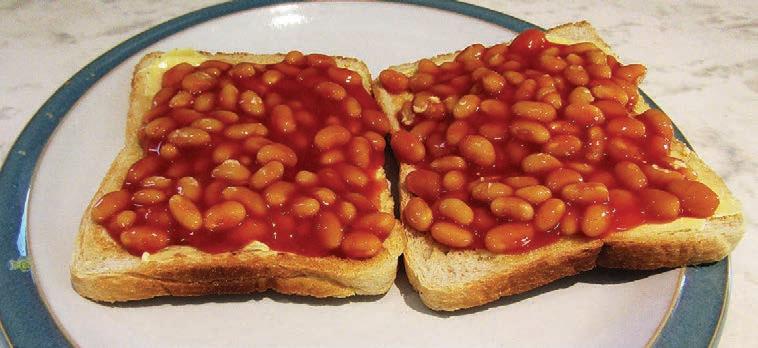
A FARMER in Lincolnshire has become the first person to cultivate a crop of baked beans in the United Kingdom thanks to pioneering research from scholars.
Andrew Ward grew a crop of baked beans, also known as haricot beans, with help from University of Warwick (UOW).
Haricot beans are imported into the UK from overseas markers due to the specific climate and soil requirements needed for their successful cultivation – but that could all change thanks to Ward and the UOW.
“At the moment we do not have any beans that are grown here that are suitable for baked beans, our climate is not right for producing this type of bean,” Ward said.
“But this is the first commercial-scale planting of a variety of haricot beans that could end up in a can on everybody’s supper table.”
The UOW said farmers can diversify their crop production and explore new market
opportunities thanks to the discovery and consumers can enjoy the freshest and highest quality baked beans which are produced in the UK.
Professor Eric Holub, from UOW’s Crop Centre, said the production of baked beans in the UK would reduce “reliance on imports” and ensure a consistent supply of a favourite breakfast essential.

“Ensuring we can produce our own food is crucial in lessening our impact on the planet.
“British-grown beans can play a big part in shaping a healthier future for all of us.
“They are a fantastic addition to our diets and contribute to the rise of flexitarian eating habits.” Holub has bred three haricot bean varieties that are adapted for growing in the UK climate and are more suited to standard farm machinery.
The new varieties – a blonde bean named Godiva, the white Capulet and black Olivia –have been selected for their versatility and are also suitable for commercial canning.
Farmers Guardian
Clarity sought on new milk contract regs
UNITED Kingdom dairy farmers have reacted with caution to a long-awaited announcement on milk contract legislation as the wait continues for clarity on what the changes will mean and whether they could really deliver.
At the Great Yorkshire Show this
month, Farming Minister Mark Spencer said the government’s plans for supply chain intervention, which he expects to be legislated on before Christmas, would give power back to dairy farmers to challenge prices and stop contract changes being
imposed without agreement.
“I know how hard it is to get up every morning to milk the cows day in and day out to produce milk, so this is as great a time as ever to ensure there is fairness and transparency in the dairy sector. In the past, there has not been a referee when there are disagreements between farmers and processors, but this is where the government will step in if necessary.”
However, he added the government would not undermine the flexibility processors needed, but farmers “should always be confident” in the price they receive and that it links to the market.
But dairy analyst Chris Walkland was cynical, saying it is “a joke” that the enabling legislation is still not ready and that there is no guarantee that it will make farmers better off.

“In terms of the specifics in the announcement, it is disingenuous and misleading of the minister to state that these regulations will provide price certainty and stability for farmers because those
are entirely market-related and the dairy market is neither certain nor stable,” he said.
He suggested this might be achieved if the Department for Environment, Food and Rural Affairs (Defra) was to underwrite a minimum selling price for milk, but said this is not going to happen.
is concerned about the lack of detail from Spencer about specific pricing.
He said farmers have been “held to ransom” by processors lowering prices and making abrupt changes.
“Dairy farmers themselves need to be involved in setting a fair price without greed coming into play,” he said, questioning whether the reality will be fairness for farmers or processors.
National Farmers’ Union dairy board chair Michael Oakes described the announcement as a “significant step forward” in offering farmers assurance over the price of milk production.
Walkland added prices are already transparent “if you know where to look”, but he highlighted there are positives as the legislation will tighten up rules on notice periods and improve other aspects of the farmer-processor relationship.
Dairy farmer Brett Hall of Bedale, North Yorkshire, said he
“For a long time, unfair milk contracts have held British dairy businesses back and these changes will give dairy farmers much needed business security and confidence, as well as helping to share risk along the dairy supply chain,” he said.
Dairy UK said the regulation will benefit dairy farmers in the future, and needs to strike the “right balance” on greater transparency. Farmers Guardian
20 World FARMERS WEEKLY – farmersweekly.co.nz – July 24, 2023 World 20
We have technologies which can reduce emissions, but these are not going to get us even halfway towards that goal of 64%.
Dr Mark Young Centre for Innovation Excellence in Livestock
HELP NEEDED: Dr Mark Young says farmers should not be expected to deliver emissions reduction strategies on their own.
A BRITISH BEAN: Baked beans cultivated in the UK could become a thing of the future after a Lincolnshire farmer grew the country’s first commercial crop of haricot beans.
IN CHARGE: Government plans in the United Kingdom for milk supply chain intervention will give power back to dairy farmers to challenge prices.
I know how hard it is to get up every morning to milk the cows day in and day out to produce milk.
Mark Spencer UK Farming Minister
128 and 248 Stokes Road
Lake side beauty!
A property, the likes of which you are unlikely to find anywhere else. Bound by Lake Karapiro along its eastern boundary, with quite easy vehicle access right to the river's edge and 3 - 4 amazing sandy beaches at your disposal. The potential for recreational use of this area needs to be seen to be appreciated, although the neighboring properties would be some sort of clue as to the potential that could be realized. The contour is, in the main, easy to rolling with some steeper sidlings, some of which do have a moderate gorse infestation, some of which has been sprayed. Power pylons do transverse the farm but in the main they are well away from houses and sheds. Generally, the property is presented in an average/poor condition only, with deferred maintenance being fairly obvious, however this should not blind interested parties from seeing what an exciting opportunity this offering presents with scope of vision and the ability to turn vision into reality.
4 2 For Sale By Negotiation + GST (if any) View By appointment Web pb.co.nz/TWR163250
John Sisley
M 027 475 9808 E john.sisley@pb.co.nz
David McGuire
M 027 472 2572 E david.mcguire@pb.co.nz















Together Stronger
Our combined strengths complement each other, creating more opportunity for our customers and Farmlands shareholders across provincial New Zealand.






• A nationwide network from Northland to Southland





• Sound, trustworthy advice from market-leading experts
• Shareholder benefits and preferential commission rates means more money in your pocket
Bigger networks, more buyers, better results
For more information call 0800 367 5263 or visit pb.co.nz/together
 Maungatautari
Maungatautari
Property Brokers Ltd Licensed REAA 2008 PB062743
Property Brokers Ltd Licensed REAA 2008 pb.co.nz Proud to be here 21 Real Estate
Darfield 2687 Coaltrack Road
Investment opportunity
Waikirikiri Farm is an exceptional investment opportunity that allows you to acquire a 50% stake in a high-quality dairy farming enterprise located less than 50km from Christchurch. The farm supplies milk to Fonterra, New Zealand's largest co-operative. By joining forces with established dairy farmers Steve and Angela Reed, who have a proven track record of consistent performance and are recognized for their ability to elevate land, animals, and people to exemplify industry best practices, you will co-invest in Waikirikiri Farm Partners LLP. Your investment will encompass the purchase of a share in the partnership, including the land 219.7009 hectares (more or less), buildings, infrastructure, livestock, plant, equipment, and associated borrowings. bayleys.co.nz/5521423



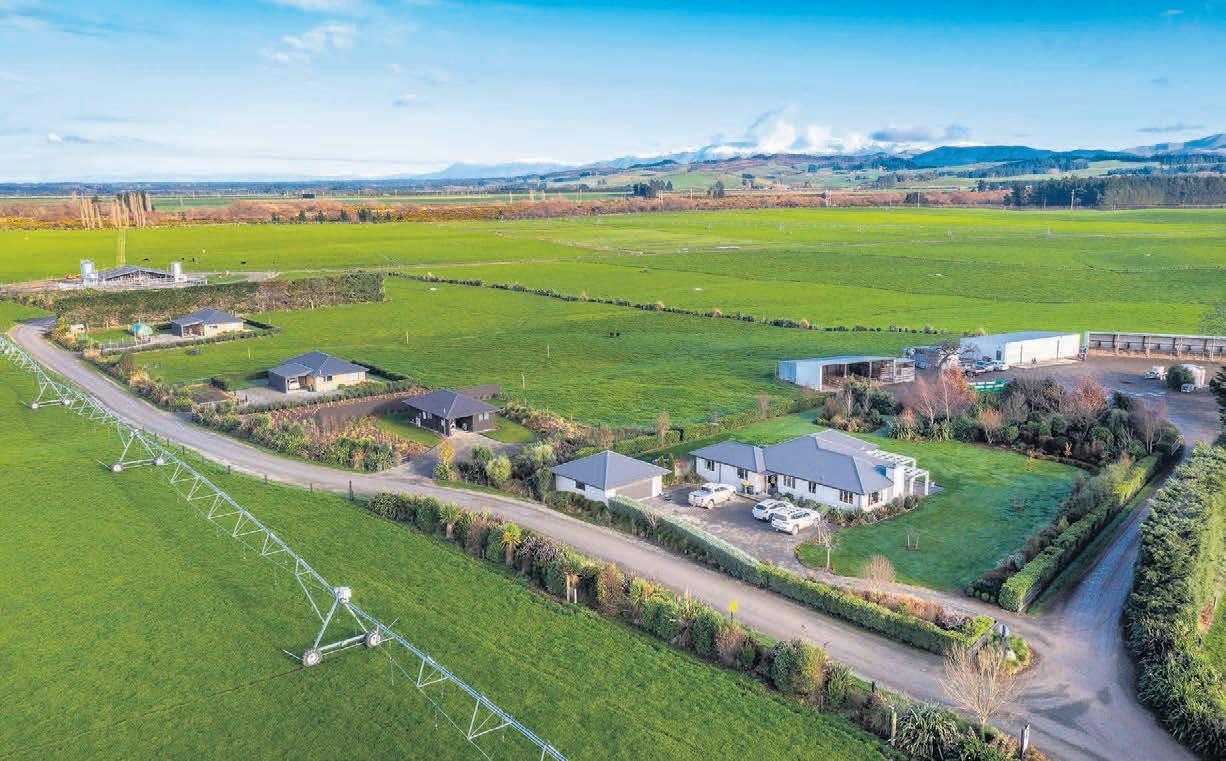
219.7009ha
Set Sale Date (unless sold prior)
12pm, Mon 7 Aug 2023
3 Deans Avenue, Chch
View by appointment
Ben Turner 027 530 1400 ben.turner@bayleys.co.nz
Craig Blackburn 027 489 7225 craig.blackburn@bayleys.co.nz
WHALAN AND PARTNERS LTD, BAYLEYS, LICENSED UNDER THE REA ACT 2008
22 FARMERS WEEKLY – farmersweekly.co.nz – July 24, 2023 Real Estate 22 Advertise with us Reach every farmer in New Zealand every week Call 0800 85 25 80 Email realestate@agrihq.co.nz
New intake for Silver Fern Farms Livestock Talent open
“It’s a privilege to be a trusted part of farmers’ businesses and livelihoods.”
That’s the key takeaway from new Livestock Rep Ben Sherratt after landing a coveted place in Silver Fern Farms’ inaugural Livestock Talent Programme.
Sherratt, who hails from Tangiwai near Waiouru and has recently completed a Bachelor of Commerce (Agriculture) at Lincoln University, is now seven months into a programme focused on bringing the next wave of talent into Silver Fern Farms’ livestock team.
Livestock Reps are the core part of the company’s relationships with its 16,000 farmer suppliers and it has a wealth of experienced Reps working for the business.

However, more than 50% of the company’s Reps are now over 50, and 20% are over 60. It is also under-represented by millennials and women.
Silver Fern Farms’ Livestock Talent Programme brings in the next generation of Reps to learn, develop and build their skill set on the job, and be provided with development and mentorship from existing Reps.

The first year of the programme last year saw more than 130 applications for four roles, with more than 50% of applications coming from women.
Sherratt says that the mentorship and guidance from the current livestock Reps makes for a fast learning curve and plenty of opportunities.
“The company culture is great, and you really are welcomed into the programme with open arms. Not only are the Reps happy to share what they’ve learnt over many years, you’re also given plenty of responsibilities and opportunities for hands-on experience pretty early on,” he says.
The programme is split into three phases. The first phase is an induction where the new Reps get experience working right across New Zealand and access to a company vehicle. They work with different
Reps in various regions to learn the ropes.
Next comes a placement in one of five regions across the country, with the mentorship of a local Rep. Finally, Reps are placed into a location with training and development opportunities.
Sherratt is currently covering a Rep’s region in Northland and says the role really suits those who like dealing with people, are organised, and who prefer a bit of variety in their work.
“As a Livestock Rep, no one day is identical. I’m down different driveways every day, I’m working closely with the processing sites and livestock transport, and I’m sitting at the kitchen table talking
to farmers about their businesses,” he says.
“Building strong relationships is really important, and some of our Reps are even godfathers to suppliers’ children. I’ve also found that many farmers are excited about the next generation coming through and the perspectives we bring.”
The next intake for the Livestock Talent Programme is now open until the 6th of August and applicants can apply on Silver Fern Farms’ website.
Applicants don’t necessarily need any prior experience or qualifications, just a background in farming or agriculture, curiosity and a can-do attitude. You’ll learn the rest on the job.
ADVERTISEMENT
Ben Sherratt and Tyla Toheriri from Silver Fern Farms’ inaugural Livestock Talent Programme.
23 Marketplace FARMERS WEEKLY – farmersweekly.co.nz – July 24, 2023 Marketplace 23
“It’s a privilege to be a trusted part of farmers’ businesses and livelihoods.”
STOCK MANAGER/STATION 2IC –SMEDLEY STATION


A BIT ABOUT SMEDLEY STATION – Smedley Station is a commercial agricultural training operation located in Central Hawke’s Bay, 40 km’s west of Waipukurau near the Ruahine Ranges. A diverse enterprise mix of sheep, cattle, and deer ensures the young Kiwis they train can become the very best future farmers of New Zealand. Over the last 90 years of training cadets, Smedley has grown to its current size of 5,600ha (3,400ha effective), wintering 30,000su.
THE OPPORTUNITY – Reporting directly to the Business Manager, the Stock Manager/Station 2IC will be based on the 960ha Smedley Block. The Stock Manager/Station 2IC will work closely with the cadets under their guidance each day, helping them with stock shifts, horse work and dog training, whilst also maintaining and improving the already high performing breeding stock.
In addition to the Stock Manager aspect of this role, it incorporates the responsibilities of 2IC at the Station and is therefore a senior level position within the Smedley team. The Stock Manager/ Station 2IC must be a person the Business Manager can rely on, who can assume overall (multiblock) stock management oversight, in the absence of the Business Manager at various times throughout the year.
A BIT ABOUT YOU – you will be a person able to mentor young cadets in a positive and proactive way, whilst also having the ability to support and guide the Block Managers when needed. To succeed in this role, you will bring:
• Proven experience on stations of scale.


• Ability to provide input into overall station stocking policies to achieve stock production targets.


• Proficiency around the training and working of dogs, with the ability to transfer this skillset to cadets.


• High personal standards, a strong work ethic and good communication skills, setting a highquality example.



ON OFFER – Smedley Station take great pride in the growth of their whole team (cadets and staff), offering career development opportunities including a range of off-farm courses currently funded through AGMARDT. The successful applicant will be driven and have the desire to continually develop themselves. The Business Manager will include them in the policy, planning and budget discussions where new ideas will be encouraged and welcomed.
As well as the above development offered, accommodation is by way of a warm, well-appointed three-bedroom home, with two bathrooms and a lockable garage. Tikokino has a strong rural community with a local rural Primary School and Kindergarten. Hawke’s Bay also has a range of excellent High Schooling and boarding options. There are plenty of recreational activities nearby as well as Waipukurau, Hastings and Napier all being within a 25 - 40 minute drive away.
FURTHER INFORMATION – For further information on the role or to apply please visit https://bit. ly/3Dp3t4x or give the Rural Directions team a call on 06 871 0450 for a confidential chat (Ref# 1065363). Applications close Sunday 30th July 2023
4X4 TAGALONG TOURS

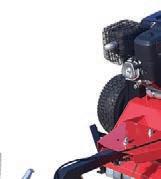
Bring your own 4X4 on a guided tour to discover more of the South Island.


Tour 1: Molesworth Station, St James, Mailings Pass & Rainbow Stations
Dates: 2023 – Nov 13-16
2024 – Feb 19-22, March 4-7, March 11-14, March 25-28 April 8-11, April 22-25
Tour: 2 D’Urville Island and Marlborough Farms Tour


Dates: 2024 – Feb 11-15, March 12-16 FULL, April 24-28
Other dates available for groups of 6 or more people on request
Ph: 0274 351 955


E: info@southislandtoursnz.com • www.southislandtoursnz.com

GLEN MURRAY – FARM MANAGER
Mahuta Stud (mahutastud.co.nz) is looking for a Farm Manager to lead the day-to-day operations of their 400ha property. The farm is run as two blocks, with stock including 230 Hereford stud cows, and 800 breeding ewes. A key highlight to every year is the annual bull sale held in September each year. Running both intensive and extensive grazing systems, variety is plenty here. Surplus cattle and sheep are also finished on the property.



The ideal applicant is someone with a minimum five years farming experience, preferably having a good work ethic, committed to the role, flexible and agile thinking, and enjoys working with cattle. A keen eye for detail is advantageous. If you want to gain experience in intensive farming, performancebased breeding and using EBV’s as part of a breeding operation then this may be the role for you. Management experience is not essential, as the farm owner is available for mentoring and guidance. A four-bedroom Golden home is available and school buses pick up children from the end of the road. The property is 23km from Te Kauwhata and 35 minutes from Pukekohe.
Please apply with cover letter and CV to recruitment@agfirst.co.nz
Applicants must have NZ residency or valid NZ work visa








Application close date: Friday 28th July 2023
Find primary sector vacancies at:

To advertise phone Debbie 06 323 0765

LK0116112© Register to receive job alerts on www.ruraldirections.co.nz
LK0116168©
farmersweeklyjobs.co.nz
LK0115530©
Heavy duty, long lasting incinerators Three sizes available Phone 021 047 9299 irontreeproducts.co.nz JW114362© GO THE MOA! To find out more visit www.mowermaster.co Phone 0800 422277 or 028 461 5112 Email: mowermasterltd@gmail.com Towable Flail Mower 14.5HP. Vanguard Briggs & Stratton Motor. Electric start. 1.2m cut 3 year Briggs and Stratton Commercial Warranty. 2 year Mower Master Warranty LK0115830© $4900 GST INCLUSIVE MOWER MASTER TOWABLE MOWERS Assembled by Kiwis for Kiwi conditions – built to last. 24 FARMERS WEEKLY – farmersweekly.co.nz – July 24, 2023 Marketplace 24 Blanket your baby in love with a large (120cm x 95cm) NZ Merino heirloom blanket Gentle on baby. Gentle on the environment. $99 www.naturesgiftforbaby.com withindeliveryFree NZ Peony Pink Blue Sky Undyed Natural Chocolate Kisses LK0116072©
Get the right fencing contractor for the job. Visit the Find a Fencing Contractor map and directory on our website today.



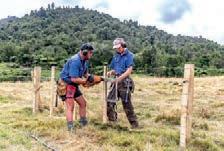

UNITED WHEATGROWERS NZ LTD

Annual General Meeting, Electoral Committee Meeting and Wheat Awards
Thursday 10th August 2023, Commencing at 1:30pm
The Chairman and Directors of United Wheatgrowers (NZ) Ltd invite all wheat growers to their Annual General Meeting and Electoral Committee Meeting held at the Sudima Hotel Christchurch Airport, 550 Memorial Avenue, Harewood, Christchurch 8053 on Thursday 10th August 2023 commencing at 1:30pm. This meeting will conclude at approximately 3pm, followed by Herbage Seed meeting and then the Arable Awards dinner and presentation.
The Arable Awards are to be held at The Wigram Airforce Museum of New Zealand, 45 Harvard Avenue, Wigram, Christchurch 8042 on Thursday 10th August 2023 commencing at 6:00pm. All wheat growers are encouraged to attend this meeting.
ANIMAL
Electrodip
HORTICULTURE
RAMS FOR SALE
www.electrodip.com
FARM MAPPING MEASURE YOUR FARM’S e

ective area with a practical and cost-e ective map.
NZ KELP. FRESH, wild ocean harvested giant kelp. The world’s richest source of natural iodine. Dried and milled for use in agriculture and horticulture. Growth promotant / stock health food. As seen on Country Calendar. Orders to: 03 322 6115 or info@nzkelp.co.nz
LEASE LAND WANTED

DAIRY OR GRAZING FARM wanted. Open to leasing and/or share farming and developing land in partnership. Rangitīkei, Manawatū or HB areas. Phone Michael 027 223 6156.
TOO MANY WILD DEER on your farm? Two older experienced hunters looking for a fallow block to hunt regularly in the Wanganui area. Ray Wisnewski 027 553 3729 or contact Steve Hibbell 021 118 1341.

MID WINTER SALE
BALAGE FOR SALE
EXCELLENT QUALITY, $85 per bale plus GST. Unit loads available. Phone 021 455 787.
THIS SEASON’S QUALITY balage. 300 x $70 a bale, including gst. Located central NI. Phone 027 367 7832.
DOGS FOR SALE
ORDERS BEING ACCEPTED for strong eyed heading pups. Both dog and bitch big robust dogs. Very strong eyed, hardy constitution and very rm. Bitch will be mated when orders lled. Phone 03 248 5149 or 027 430 1659.
WELL BRED HEADING pups for sale. 7 weeks old. Sire by A Owens Cap (world champion). Dam by B Bruce Cheat. Proven cross. Waikato. Phone 021 557 119.
30 DOGS UNDER 30 hundred. Deliver NZ wide twice monthly.
www.youtube.com/user/ mikehughesworkingdog/ videos 07 315 5553.
PUPS, 3/4 BEARDIE, 1/4 red border. Four dogs, three bitches, born May 4th. Phone 022 026 4975.
PURINA PROPLAN

WHATATUTU dog sale. Saturday 12th August.

At Otara Station, 319 Whatatutu Road, Te Karaka, Gisborne. Sales start at 12 noon. Dosing clearance required. Enquiries and to enter go to: Whatatutu Dog Sale - Facebook page or phone 027 443 8350.
Buy $100+ code: Save 10% www.thesocklady.co.nz
PROMOTES QUICK PASTURE growth. Only $6.50+gst per hectare delivered. 0508-GIBBGRO [0508 442 247] www. gibbgro.co.nz. “The Proven One.”
GOATS WANTED INCREASE PASTURE growth and dry matter. $5.50 per/ha ex store + GST. Phone 0508 733 343. www.vernado.co.nz GOATS WANTED. All weights. All breeds. Prompt service. Payment on pick up. My on farm prices will not be beaten. Phone David Hutchings 07 895 8845 or 0274 519 249. Feral goats mustered on a 50/50 share basis. GRAZING AVAILABLE HOGGETS. CATTLE. Location Bulls, Rangitikei -
from Mid Aug. Text 021 224 2119, testimonials available.
HAY FOR SALE
QUALITY RYE GRASS and barley straw. Shed stored and covered stack. Weed free. Round and square bales, Waimate, South Canterbury. Unit loads available, can deliver. Phone Dan 021 760 407.
LIVESTOCK FOR SALE
RED DEVON BULLS. Well grown, purebred. Feilding. Phone 027 224 3838.
RURAL MASSAGE
RELAXING FULL BODY massage in rural Ohaupo. Unwind. De-stress. www. ruralmassage.co.nz or call 027 529 5540.
WILTSHIRES-ARVIDSON. Self shearing sheep. No1 for Facial Eczema. David 027 2771 556.
WANTED TO BUY
HOUSES AND SHEDS for shifting, relocating and removal. Phone 021 455 787.
SAWN SHED TIMBER including Black Maire. Matai, Totara and Rimu etc. Also buying salvaged native logs. Phone Richard Uren. NZ Native Timber Supplies. Phone 027 688 2954.

WHAT’S SITTING IN your barn? Don’t leave it to rust away! We pay cash for tractors, excavators, small crawler tractors and surplus farm machinery. Ford –Ferguson – Hitachi – Komatsu – John Deere and more. Tell us what you have no matter where it is in NZ. You never know.. what’s resting in your barn could be fattening up your wallet! Email admin@ loaderparts.co.nz or phone Colin on 0274 426 936 (No texts please)
SALE TALK
Advertise with us Call Debbie 027 705 7181
SHEEP FARMERS
Follow us on Facebook for updates. Grand opportunity to purchase exceptional well-bred lines of hill country station bred Cattle.
Jamie Hayward 027 434 7586
Chris Hurlstone 027 598 6542 www.agonline.co.nz
East Coast Advertise with us Call Andrea 027 602 4925 www.dyerlivestock.co.nz Ross Dyer 0274 333 381


SHORN MALE LAMBS R1YR FRSN BULLS 180-230kg 420-480kg R2YR FRSN BULLS or XBREDS 380-450kg R2YR ANG, ANG & EX X (& DAIRY X) STEERS 420-480kg R3YR ANG & AX or EXOTIC STEERS 500-600kg E info@rdlfinance.co.nz A Financing Solution For Your Farm 25 M-Place/Livestock Marketplace Livestock 25 DOLOMITE For a delivered price call .... NZ’s finest BioGro certified Mg fertiliser 0800 436 566 ATTENTION FARMERS electro-tek@xtra.co.nz Phone: 06 357 2454 ELECTRO-TEK ENGINEERING Re-sharpening available for all makes FOR SALE Electronic, timed animal feeder Feeds a broad range of domestic and farm animals. For more information or to order see: www.durafeed.nz

WORMFEC
GOLD
You can achieve high performance without capsules by:
- Feeding ewes at levels above 1200 kg/ha
- Maintaining condition score 3+ for ewes


- Using WormFEC Gold Genetics


WormFEC Gold Genetics
Performance 578c above national MW flock average
Able to withstand Barbers Pole Challenge
Now including low dag score in their selection
SETING INDUSTRY STANDARDS SETTING INDUSTRY STANDARDS
A FENCING CONTRACTOR WWW.FCANZ.ORG.NZ
FIND
LK0116061©
SUPPORTS WORMWISE MANAGEMENT STRATEGIES FOR PARASITE CONTROL
Helping grow the country
- Following Wormwise protocols including monitoring CATTLE SALE
www.wormfecgold.co.nz
MATAWHERO
TUESDAY, 1st AUGUST 2023, 11AM
Facebook: PGG Wrightson Livestock
STOCK REQUIRED
FLY OR LICE problem?
– the magic eye sheepjetter since 1989 with unique self adjusting sides. Incredible chemical and time savings with proven e ectiveness. Phone 07 573 8512
HANDLING CRAIGCO SHEEP JETTERS. Sensor Jet. Deal to y and Lice now. Guaranteed performance. Unbeatable pricing. Phone 06 835 6863. www.craigcojetters.com
Visit farmmapping.co.nz for a quote.
GIBB-GRO GROWTH PROMOTANT GIBBOOST
Years ago, a couple in Canada found an abandoned polar bear cub and decided to adopt and raise it themselves. By the time the bear was grown up, it had become very tame, very friendly, and rather jovial. Life with a pet polar bear turned out to be pretty fun, but one problem was that taking it on vacations wasn’t really an option. A big problem was that few climates were suitable for polar bears. One day the wife had the interesting idea of taking the polar bear to Antarctica. It seemed ideal, with a suitable temperature and nobody around to tell them not to bring in their pet. 3 weeks later, they had arrived, and were walking through the wilderness of the South Pole. The couple is excited to see how the bear will react. To the chagrin of the wife, he just slumps and seems to lack a lot of motivation. “Honey,” the wife said to her husband. “I think our poor bear is depressed. And I don’t know why; this is so opposite of how he usually is!” The husband replies, “Well, now he’s a bipolar bear.”
Markets













Beef supply starting to back up globally
FARMGATE beef prices have nudged lower in recent weeks as export sales come under pressure across New Zealand’s key markets.

The problem stems from weaker economic activity and growing inventories in these markets, not helped by powerhouse beef producers such as Brazil and Australia running at full steam. Both are heavily reliant on exports to absorb their annual production.
Since 2016, Brazil has exported more than 1 million tonnes of beef per year. Back then its distribution was more evenly spread, shipping direct to China and through the grey channels via Hong Kong, but also going into Russia and Egypt.
These days the focus is squarely on China. Of Brazil’s 1.9 million tonnes of beef exported in 2022, 61% went to China. The trend hasn’t stopped this year. China remains the largest market for Brazilian beef, and despite some hiccups earlier in the year, volumes to this market have rocketed ahead in the past two months.
Over that same extended timeframe, Australia suffered devastating back-to-back droughts. The consequences of this were a significant reduction in cattle numbers. At the height of the drought offload in 2019, Australia exported over 1.2 million tonnes of beef. Export volumes bottomed out last year at 855,000t.


The reduced presence of Australia in our key markets in the past two years helped support prices received for NZ beef. But now the tables have turned, and Australian beef production is ramping back up.

In the first six months of 2023, Australia already exported over 80,000t more beef than for the same period last year. And it doesn’t stop there.
If Australian industry forecasts are on the money, then export volumes over the remainder of the year should sit somewhere
around 540,000t – another 80,000t increase compared to the corresponding period last year. For that to happen, beef slaughter rates will have to follow seasonal trends by lifting even higher from September.
With more beef to export, Australia has pounced on opportunities in China, which had been hard to come by in recent years.
This has seen exports to there catapult – up 25,000t on the same period last year. Weaker economic activity in Japan means it barely has the stamina to compete, and scarcely holds the lead from China as being Australia’s No 1 beef market.
It’s not just China where Australia is active. The United States is seeing a lot more beef heading in its direction than for the last several years.
A solid herd rebuild at some point starts to deliver additional

cull cows, and the US lean beef market is the first port of call for this type of beef from Australia. This has coincided with ample volumes of NZ beef in recent months, which has helped push imported prices down into this market.
With more beef to export, Australia has pounced on opportunities in China, which had been hard to come by in recent years. This has seen exports to there catapult.
The sheer volume that these two countries are pouring into global markets is only part of the problem. Shaky global economic conditions continue to influence consumer demand, and this is certainly the case in China.
While the US remains staunch to the suggestion of a recession, the problem there is that they have ample supply of beef to satisfy their current needs.
With supplies building, the pressure is going to remain on export prices. If supplies aren’t going to slow, demand needs to pick up – and that’s going to take some work.
Despite the North Island beef kill surging through late June and into early July, generally, NZ production should taper off now through to late October, minimising our reliance on export markets and hopefully sheltering prices from too much further downside.
AgriHQ’s recent Livestock Outlook forecasts point to some upside in beef prices heading into spring, but expectations need to be dialled down from what they may have been a couple of months ago.

For more information and useful resources visit: www.beeflambnz.com/wintergrazing Minimise the impacts on the environment and your animals. Keep Up The Great Work This Winter Prepared for adverse weather events? Have a plan in place to cope with bad weather: how you will protect waterways and provide clean drinking water, feed and shelter to your stock. Plant a catch crop. Where soil conditions and farm management allow, consider planting a fast growing crop, such as greenfeed oats, straight after grazing. It can help reduce nitrogen and soil losses. 26 Markets
Proudly sponsored by
As Brazil and Australia ship millions of tonnes of beef across the world, the ripple effects are being felt at the farm gate in New Zealand.
Mel Croad MARKETS Beef
HAY NOW: After years of drought Australian farmers have feed to burn and production is ramping up.
Weekly saleyards
The feeder calf sale season has kicked off and PGG Wrightson’s Waikato saleyard manager, Todd van Berlo, said it was a good start. “We are only one week in but are happy with the start of the feeder season. There are good numbers of Friesian bulls arriving at the sales, and beef calf numbers are normal for the start of the season.” Van Berlo reported that the sales should show more consistent pricing in the coming weeks with more buyers appearing as they secure their supply of colostrum milk.
27
Kaikohe | July 19 $/kg or $/hd Mixed-age Angus cows, in-calf 1.84 R2 dairy-beef steers 2.75-2.92 R1 Charolais steers 3.20 R1 beef bulls 2.80-2.90 Wellsford | July 17 | 428 cattle $/kg or $/hd Mixed-age Angus cows, RWB, 581-684kg 1.65-1.74 Mixed-age dairy-beef cows, 513-606kg 1.65-1.72 R3 Hereford, dairy-beef steers, 521-686kg 2.70-2.84 R2 dairy-beef steers, 433-501kg 2.60-2.70 R2 Hereford-Friesian heifers, 305-479kg 2.59-2.67 R1 exotic-cross, dairy-beef steers, 224-350kg 680-940 R1 Angus bulls, 221-256kg 650-740 R1 beef, exotic-cross, dairy-beef heifers, 245-356kg 605-860 Tuakau | July 13 | 400 cattle $/kg or $/hd R2 beef, dairy-beef steers, 440-540kg 2.67-2.82 R2 heifers, 390-450kg 2.65-2.75 R1 beef, dairy-beef steers, 250-310kg 3.22-3.32 R1 heifers, 250-330kg 2.55-2.66 Tuakau | July 17 | 710 sheep $/kg or $/hd Store lambs, all 60-90 Prime ewes, all 80-116 Prime lambs, all 130-166 Tuakau | July 19 | 190 cattle $/kg or $/hd Prime beef cows, 500-550kg 2.08-2.27 Prime steers, 520-720kg 2.89-2.98 Prime heifers, 500-580kg 2.80-2.99 Rangiuru | July 18 | 136 cattle, 43 sheep $/kg or $/hd R2 Hereford-Friesian steers, 480kg, one line 2.88 R2 dairy-beef heifers, 318-360kg 790-850 R1 dairy-beef bulls, 168-155kg 575-590 R1 Angus heifers, 230-253kg 3.14-3.15 Prime dairy-beef steers, 603-670kg 2.88-2.97 Boner dairy cows, 490-635kg 1.90-2.03 Store lambs, all 69-110 Prime lambs, all 116.50-142 Frankton | July 12 | 460 cattle $/kg or $/hd R2 dairy-beef steers, 371-505kg 2.70-2.80 R2 dairy-beef heifers, 410-435kg 2.50-2.66 R1 beef, dairy-beef bulls, 230-280kg 550-700 Aut-born weaner Friesian, dairy-beef bulls, 94-104kg 580-670 Prime dairy-beef steers, 560-672kg 2.86 Prime dairy-beef heifers, 446-572kg 2.68-2.73 Boner Friesian-cross cows, 390-446kg 1.62-1.76 Frankton | July 18 | 303 cattle $/kg or $/hd R2 dairy-beef steers, 415-444kg 2.66-2.86 R2 dairy-beef heifers, 378-443kg 2.75-2.85 Aut-born yearling Hereford-Friesian steers, 298-371kg 2.76-2.92 R1 steers, 243-293kg 580-820 Aut-born weaner Charolais-Friesian steers & heifers, 98-101kg 490-610 Prime Angus-cross cows, 400-486kg 2.05-2.15 Prime beef, exotic, dairy-beef steers, 522-706kg 2.84-2.96 Prime dairy-beef heifers, 468-544kg 2.72-2.85 Boner Friesian, Friesian-cross cows, 487-641kg 1.86-1.98 Frankton | July 19 | 350 cattle $/kg or $/hd R2 Angus-Wagyu heifers, one line, 455kg 2.74 R1 beef-cross steers, 182-193kg 610 R1 dairy-beef heifers, 160-181kg 550-570 Aut-born weaner Belgian Blue-Friesian bulls, 113-171kg 630-720 Aut-born weaner dairy-beef bulls, 105-124kg 535-600 Aut-born weaner Belgian Blue-Friesian heifers, 113-126kg 440-475 Aut-born weaner Hereford-Friesian heifers, 101-175kg 500-580 Prime Hereford bulls, one line, 707kg 3.04 Boner Friesian cows, 413-755kg 1.94-2.05 Matawhero | July 13 | 765 sheep $/kg or $/hd 5-year Romney ewes, SIL Romney 14/03, 184%, very good 110-120 Store ram lambs, heavy 111-111.50 Store ewe lambs, good to heavy 82-93 Taranaki | July 12 | 338 cattle $/kg or $/hd R3 Hereford-Friesian heifers, 420-423kg 2.71-2.84 R2 Angus steers, one line, 425kg 3.20 R2 Hereford-Friesian steers, 374-536kg 2.95-3.02 R2 Speckle-dairy, Angus-Friesian steers, 436-480kg 2.83-2.89 R2 Hereford heifers, one line, 379kg 2.72 R2 dairy-beef heifers, 328kg-405kg 2.81-2.87 R1 Charolais-dairy steers, one line, 329kg 3.47 R1 beef-cross heifers, 202-290kg 695-880 R1 Charolais-dairy heifers, 267-319kg 865-970 Taranaki | July 19 | 131 cattle $/kg or $/hd R2 exotic-cross, dairy-beef steers, 375-521kg 2.90-3.05 R1 dairy-beef steers, 190-260kg 720-980 Aut-born weaner dairy-beef, crossbred steers, 118-140kg 400 Prime dairy-beef steers, 622-715kg 2.95-2.99 Boner Friesian cows, 542-621kg 1.74-1.88 FARMERS WEEKLY – farmersweekly.co.nz – July 24, 2023 Markets 27
It’s time that we all take the wheel.
Working in and around vehicles is a leading cause of serious, and fatal injuries on farms. And with farmers over 55 being the most affected group - it’s not about experience.
It’s time our whole community steps up, to set a new standard... for ourselves, and for everyone we work alongside and care about.
SIGN THE PLEDGE, AND JOIN THE CHANGE. AT farmwithoutharm.org.nz

|
17 | 156 cattle, 3122 sheep
28 FARMERS WEEKLY – farmersweekly.co.nz – July 24, 2023 Markets 28 Stortford Lodge | July 12 | 97 cattle, 2655 sheep $/kg or $/hd Mixed-age dairy cows, 462-560kg 1.79-1.86 R2 traditional steers, 433-489kg 3.20-3.28 Mixed-age Romney ewes, SIL Kelso 01/04 165%, medium to good 143-170 Store cryptorchid lambs, heavy 114-131.50 Store ewe lambs, medium to good 74-94.50 Stortford Lodge | July 17 | 588 cattle $/kg or $/hd Prime ewes, good to heavy 100-116 Prime ewes, light-medium to medium 69-81 Prime ewes, light 30-51 Prime lambs, heavy to very heavy 138-170 Prime lambs, good 132.50-133 Stortford Lodge | July 19 | 253 cattle, 2732 sheep $/kg or $/hd Mixed-age traditional cows, in-calf, 544-660kg 1.99-2.19 R2 dairy-beef steers, 464-519kg 2.81-2.93 R2 traditional heifers, 416-467kg 2.83-2.94 R1 Charolais-beef heifers, 160-208kg 3.50-3.54 Store lambs, heavy 126-159.50 Store male lambs, good 98-122 Store ewe lambs, medium to good 90-110 Dannevirke | July 13 | 912 sheep $/kg or $/hd Store cryptorchid lambs 108 Store ewe lambs, one line 78.50 Store & prime ewes, all 50-80 Feilding | July 13 | 335 cattle, 2985 sheep $/kg or $/hd R2 traditional steers, 391-520kg 2.94-3.09 R2 Hereford-Friesian steers, 455-494kg 2.90-2.95 R2 dairy-beef bulls, 459-506kg 2.94-2.98 R1 beef-cross, dairy-cross bulls, 220-305kg 760-940 5-year Romney ewes, SIL Charollais, Suftex; singles, twins 121-136 Store whiteface male lambs, heavy 118-139 Store whiteface male lambs, woolly, medium-good 74-81 Store ewe lambs, good 88-104 Store ewe lambs, medium 81-100 Feilding
$/hd Prime traditional bulls, 1030-1080kg 1.00-1.01 Prime traditional bulls, 650-660kg 2.72 Prime dairy-beef heifers, 328-361kg 1.29-1.30 Boner Friesian cows, 463-629kg 1.58-1.66 Prime ewes, very good 117-134 Prime ewes, good 101-110 Prime male lambs, very heavy 162-172 Prime male lambs, heavy 151-160 Prime ram & cryptorchid lambs, very heavy 172-191 Prime mixed-sex lambs, very heavy 161-180 Prime mixed-sex lambs, heavy 138-158 Rongotea | July 18 | 36 cattle $/kg or $/hd R2 Jersey bulls, one line, 493kg 2.72 R2 Hereford-Friesian heifers, 405-575kg 2.64-2.76 R1 Hereford-Friesian bulls, one line, 262kg 2.87 Boner Friesian cows, one line, 460kg 1.52 Coalgate | July 13 | 164 cattle, 1284 sheep $/kg or $/hd R2 traditional steers, 422-433kg 3.16-3.32 R2 traditional, exotic heifers, 407-409kg 3.00-3.11 Prime Hereford-Friesian steers, 493-638kg 2.82-2.92 Prime Angus heifers, one line, 421kg 2.86 Prime Hereford-Friesian heifers, 405-565kg 2.70-2.88 Store mixed-sex lambs, all 50-114 Store ewe lambs, all 60-109 Prime ewes, tops 132-172 Prime ewes, medium to good 64-125 Prime lambs, most 120-183 Canterbury Park | July 18 | 69 cattle, 1432 sheep $/kg or $/hd Prime traditional steers, 475-538kg 2.88-2.92 Prime beef, dairy-beef heifers, 450-530kg 2.70-2.80 Prime dairy-beef heifers, 558-730kg 2.04-2.16
July
$/kg or


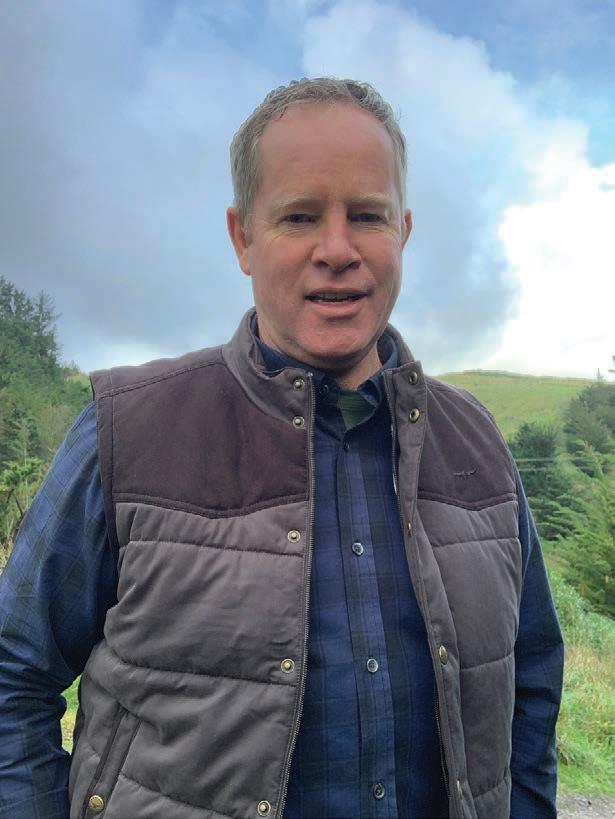
29 LK0116164© FARMERS WEEKLY – farmersweekly.co.nz – July 24, 2023 Markets 29 Store Corriedale mixed-sex lambs, one line, heavy 126 Store lambs, good 92-113 Store whiteface lambs, medium 82-108 Prime ewes, medium 67-80 Prime lambs, good to very good 125-168 Temuka | July 17 | 128 cattle, 1783 sheep $/kg or $/hd Prime Hereford-Friesian steers, 445-745kg 2.60-2.80 Prime Hereford-Friesian heifers, 510-640kg 2.66-2.77 Boner Friesian cows, 500-745kg 1.84-1.93 Store mixed-sex lambs, heavy 119-124 Store Halfbred mixed-sex lambs, all 85-103 Prime ewes, most 85-110 Prime mixed-sex lambs, most 135-150 Balclutha | July 12 | 631 sheep $/kg or $/hd Store lambs, all 30-100 Prime ewes, all 30-98 Prime lambs, all 118-160 Balclutha | July 19 | 230 sheep $/kg or $/hd Store lambs, all 50-100 Prime ewes, all 40-122 Prime lambs, all 117-153 Charlton | July 13 | 461 sheep $/kg or $/hd Store lambs, all 35-100 Prime ewes, all 45-120 Prime lambs, all 114-160 Lorneville | July 18 $/kg or $/hd R2 Angus steers, one line, 380kg 1070 R2 Belgian Blue-cross heifers, one line, 360kg 970 R1 Charolais-cross steers, one line, 225kg 715 R1 Charolais-cross heifers, one line, 230kg 675 Prime steers, 500kg 2.80 Prime steers, 400-450kg 2.40-2.50 Store lambs, all 75-120 Prime ewes, all 50-120 Prime lambs, all 120-178 Feeder Calf Sales | July 17 - July 19 Tuakau | July 17 | 225 cattle $/kg or $/hd Friesian bulls, small to good 60-145 Hereford-Friesian (black) bulls, small to good 150-250 Other dairy-beef bulls, small to good 30-130 Hereford-Friesian (black) heifers, medium to good 100-200 Other dairy-beef heifers, small to good 30-90 Paeroa | July 17 | 247 cattle $/kg or $/hd Friesian bulls, small to good 70-170 Dairy-beef bulls, medium to good 130-190 Dairy-beef heifers, medium 120-150 Angus-cross heifers, small to good 60-115 Frankton | July 18 | 557 cattle $/kg or $/hd Friesian bulls, medium to good 125-195 Friesian bulls, small 60 Hereford-Friesian (black) bulls, small to good 120-280 Hereford-Friesian (red) bulls, small to good 40-160 Charolais-cross bulls, small to good 120-250 Angus-cross bulls, small to good 100-375 Hereford-Friesian (black) heifers, small to good 70-160 Other dairy-beef heifers, small to good 30-160 Tirau | July 19 | 336 cattle $/kg or $/hd Friesian bulls, small to good 80-170 Hereford-Friesian (black) bulls, small to good 120-280 Other dairy-beef bulls, small to good 50-150 Hereford-Friesian (black) heifers, small to good 110-150 Other dairy-beef heifers, small to medium 30-100
Cattle
Sheep Deer
NOTE: Slaughter values are weighted average gross operating prices including premiums but excluding breed premiums for cattle.



Fertiliser Forestry

Farmers Weekly fits perfectly in your pocket – save it to your Stay in touch with LK0116159© 30 FARMERS WEEKLY – farmersweekly.co.nz – July 24, 2023 Markets 30 AgriHQ market trends Sheep Meat Slaughter price (NZ$/kgCW) Last week Last year North Island lamb (18kg) 7.15 9.10 North Island mutton (25kg) 3.65 6.10 South Island lamb (18kg) 7.20 9.20 South Island mutton (25kg) 3.60 6.05 Export markets (NZ$/kg) China lamb aps 8.46 13.61 Wool (NZ$/kg clean) 12-Jul Last year Crossbred eece 3.04 2.75 Crossbred second shear 2.50 2.51 Courtesy of www.fusca.co.nz Beef Slaughter price (NZ$/kgCW) Last week Last year North Island P2 steer (300kg) 5.75 6.10 North Island M2 bull (300kg) 5.70 6.10 North Island M cow (200kg) 3.75 4.35 South Island P2 steer (300kg) 5.55 6.15 South Island M2 bull (300kg) 5.35 6.05 South Island M cow (200kg) 3.90 4.60 Export markets (NZ$/kg) US imported 95CL bull 8.44 9.48 US domestic 90CL cow 10.25 9.89 Venison Slaughter price (NZ$/kgCW) Last week Last year North Island AP stag (60kg) 8.80 8.15 South Island AP stag (60kg) 8.80 8.15 Fertiliser NZ average (NZ$/tonne) Last week Last year DAP 1297 1794 Super 447 495 Urea 885 1340 Urea (Coated) 934Exports NZ Log Exports (tonnes) May Last year China 1,891,280 1,656,760 Rest of world 160,935 190,116 Carbon price (NZ$/tonne) Last week Last year NZU 50.0 73.0
Steer slaughter price ($/kgCW) Lamb slaughter price ($/kgCW) NZ
Stag Slaughter price ($/kgCW) NZ cattle slaughter (thous. head) Data provided by
lamb & mutton slaughter (thous. head)
5.0 5.5 6.0 6.5 7.0 Jul Sep Nov Jan Mar May North Island South Island 6.0 7.0 8.0 9.0 10.0 Jul Sep Nov Jan Mar May North Island South Island 7.5 8.0 8.5 9.0 9.5 Jul Sep Nov Jan Mar May North Island South Island 0 20 40 60 80 100 08-Apr 08-May 08-Jun 08-Jul 08-Aug 08-Sep 5-yr ave This year Last year 0 100 200 300 400 500 600 700 08-Apr 08-May 08-Jun 08-Jul 08-Aug 08-Sep 5-yr Ave This year Last year
NZX market trends
Dairy
Data provided by
Milk price futures ($/kgMS)
Grain
Canterbury feed wheat ($/tonne)
Close of market
Listed Agri shares
Dairy Futures (US$/t)
Nearest contract Last price* Prior week4 weeks prior
305030403025
251025502820
485049705020 Milk Price 8.228.228.24
* price as at close of business on Wednesday
WMP futures - vs four weeks ago (US$/tonne)
Canterbury feed barley ($/tonne)
Waikato palm kernel ($/tonne)
one touch
iPhone or iPad

• Open Safari. Other browsers, such as Chrome, won’t work for this.
• Navigate to farmersweekly.co.nz. Tap “Go.”
• Tap the Share button on the bottom of the page. It looks like a square with an arrow pointing out of the top.
• In the list of options that appear, scroll down until you see Add to Home Screen. Tap this. The Add to Home Screen dialog box will appear.
• Choose a name for the website shortcut. You’ll see the link so you can confirm it. Click Add when you’re done.
Android
• Open your web browser eg Chrome.
• Navigate to farmersweekly.co.nz.
• Tap the menu icon (3 dots in the upper right-hand corner) and tap Add to home screen.
• Choose a name for the website shortcut, then your browser will add it to your home screen.
homescreen
• • • • • • • • • 31 FARMERS WEEKLY – farmersweekly.co.nz – July 24, 2023 Markets 31
Company Close YTD HighYTD Low ArborGen Holdings Limited 0.1850.230.18 The a2 Milk Company Limited 5.537.835.15 Cannasouth Limited 0.230.320.23 Comvita Limited 3.23.482.75 Delegat Group Limited 8.6210.28.2 Fonterra Shareholders' Fund (NS) 3.483.792.95 Foley Wines Limited 1.251.421.18 Greenfern Industries Limited 0.0480.1130.044 Livestock Improvement Corporation Ltd (NS) 1.131.251.13 Marlborough Wine Estates Group Limited 0.1850.190.15 NZ King Salmon Investments Limited 0.20.240.191 PGG Wrightson Limited 4.194.67 4 Rua Bioscience Limited 0.1610.220.147 Sanford Limited (NS) 4.054.393.91 Scales Corporation Limited 3.414.252.75 Seeka Limited 2.83.722.25 Synlait Milk Limited (NS) 1.643.651.38 T&G Global Limited 1.992.371.97 S&P/NZX Primary Sector Equity Index 109911287010614 S&P/NZX 50 Index 119451221211531 S&P/NZX 10 Index 121081241111486
WMP
SMP
AMF 461046104900 Butter
5pm, Wednesday
S&P/NZX 10 INDEX 12108 S&P/FW PRIMARY SECTOR EQUITY 10991 S&P/NZX 50 INDEX 11945 7.0 8.0 9.0 10.0 11.0 Jul Sep Nov Jan MarMay Jul Sep-2023 Sep-2024 400 450 500 550 600 650 700 Jul Sep Nov Jan MarMay Jul 400 450 500 550 600 650 700 Jul Sep Nov Jan MarMay Jul 2850 2900 2950 3000 3050 3100 3150 3200 3250 JulAug Sep Oct Nov Dec Latest price 4 weeks ago 300 350 400 450 500 Jul Sep Nov Jan MarMay Jul
Westerly weather pattern wending its way
Philip Duncan NEWS Weather

MORE rain has recently fallen in saturated areas but for many July did see an uptick in westerlies and longer dry spells for eastern and northern areas.
The low that moved through over the weekend brought rain back to regions that recently had the sun out – but these lows from the Tasman Sea and subtropics are still expected to ease as El Niño continues to develop. We’ve already seen a notable reduction in low pressure and rainmaker
BUILDING: El Niño remains in the Alert phase – meaning it’s building and expected to be officially announced in the weeks or months ahead.
zones over the Tasman Sea and sub-tropics in recent weeks, thanks to more high pressure over Australia.
As far as El Niño is concerned, it still remains in the “Alert” phase – meaning it’s building and expected to be officially announced in the weeks (or months) ahead.

Central and eastern Pacific sea surface temperatures (SSTs) are exceeding El Niño thresholds, and have been doing so for several weeks now. Models indicate further warming is likely, with SSTs remaining above El Niño thresholds until at least the end of the year – showing that this is here to stay. However, sustained
changes in wind, cloud and broad-scale pressure patterns towards El Niñolike patterns have not yet been observed – and this is the missing piece of the puzzle so far. It means the Pacific Ocean and atmosphere have yet to become fully coupled, as occurs during El Niño events. So we have half of the equation remaining.
If you look to Australia you can see high pressure dominating more and more, bringing much wanted dry weather to Victoria but starting to concern those further inland. This dry pattern from Aussie tends to “stretch out” over the Tasman Sea and bring drier weather to New Zealand along with a west to southwest flow.
El Niño typically suppresses rainfall in eastern and northern NZ.
Soil-moisture-wise, most of NZ is wet at the moment. There’s not a region that wouldn’t mind some sun and dry days, although some

parts of South Canterbury are a bit drier than usual –but that’s the only part of NZ in that camp.
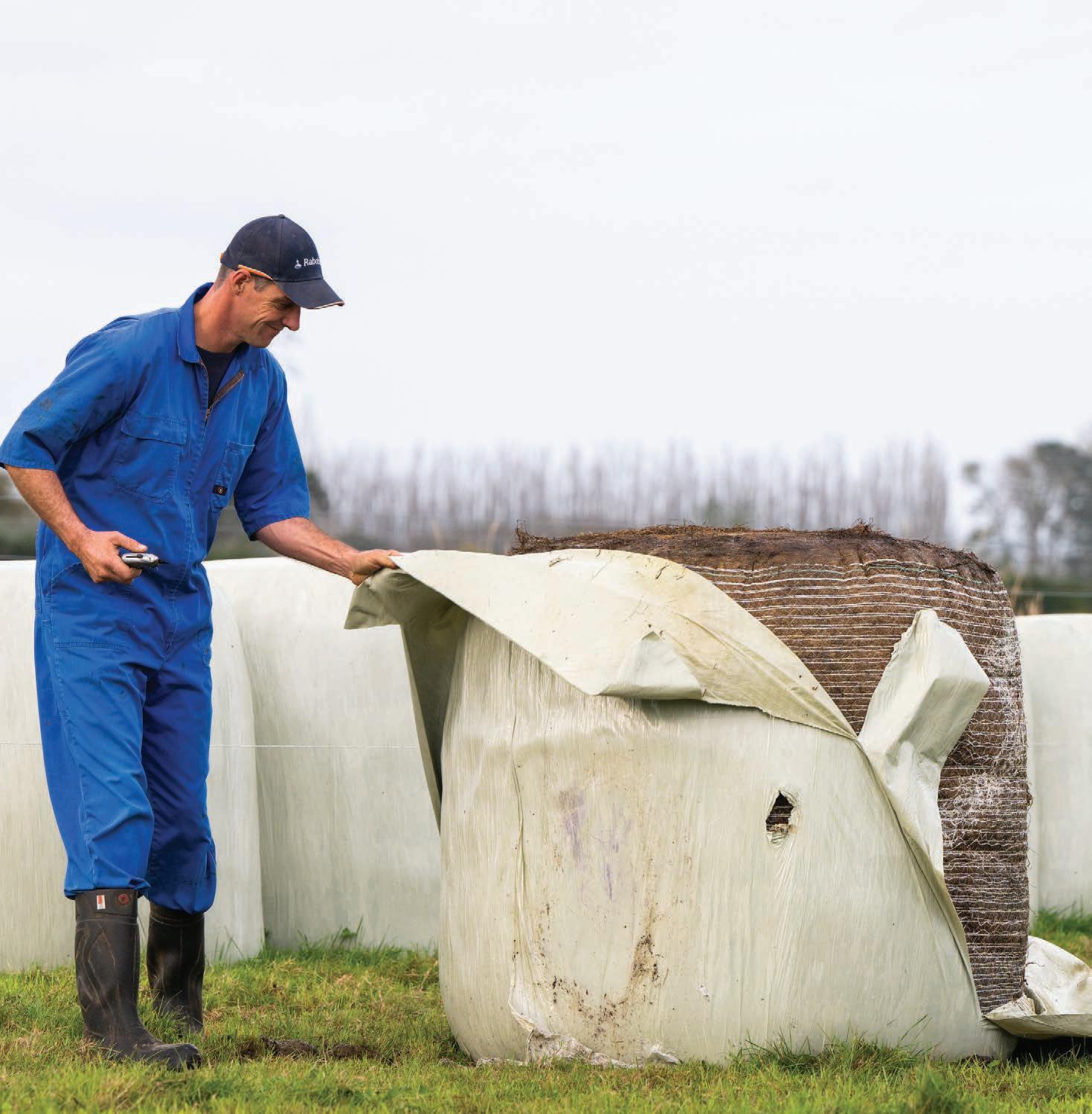
One big comment we’re getting nationwide is about how warm it is. In Southland soil temperatures are well above where they would normally be. We’re hearing word of pasture growth in the eastern North Island and lower South Island – not always the case at the very end of July! There remains a distinct lack of frosts in most NZ regions this winter.
The neutral pattern we’re in – and the partial El Niño weather pattern forming over Australia – means we’re still expecting more westerly-driven weather in the coming months.
While our location on Earth means anything can happen here, we as forecasters always try to look for patterns to help guide farmers and growers. The pattern we’re focused on now is the emerging westerly one and what that means for us in the months ahead.
GAUGE: Rainfall accumulation over seven days starting from 6am Sunday July 23 through to 6am Sunday July 30.
Highlights this week
• West to southwesterly winds return this week
• Brief high pressure crosses NZ
• Another low or rainmaker crosses from the Tasman Sea this weekend (but weaker and likely falls apart)
A flexible account that gives you the confidence to plan ahead Farming can be changeable to say the least, with the Rabobank All In One account you can manage that change Our All In One account combines transaction, working capital and term loan facilities. Make the most efficient use of your funds, get on top of your finances, and have fast access to working capital when you need it. Get the flexibility you need to manage your business, call 0800 500 933 Lending criteria and terms and conditions apply. For more information visit www.rabobank.co.nz 32 Weather ruralweather.co.nz
Everything we do, we do for the generations to come.













1
Enter the awards and help grow a healthy future for farming. BAL14020_BFEA Muster_FW Wrap_380x262mm_FA2.indd 1 7/07/23 12:38 PM Page 1 inside Vol 21 No 28, July 24, 2023 View online at farmersweekly.co.nz $4.95 Incl GST
Are you ready to enter the awards?
The Ballance Farm Environment Awards are all about growing a healthy future for farmers and growers. Being part of the awards means meeting like-minded people and sharing knowledge and ideas.
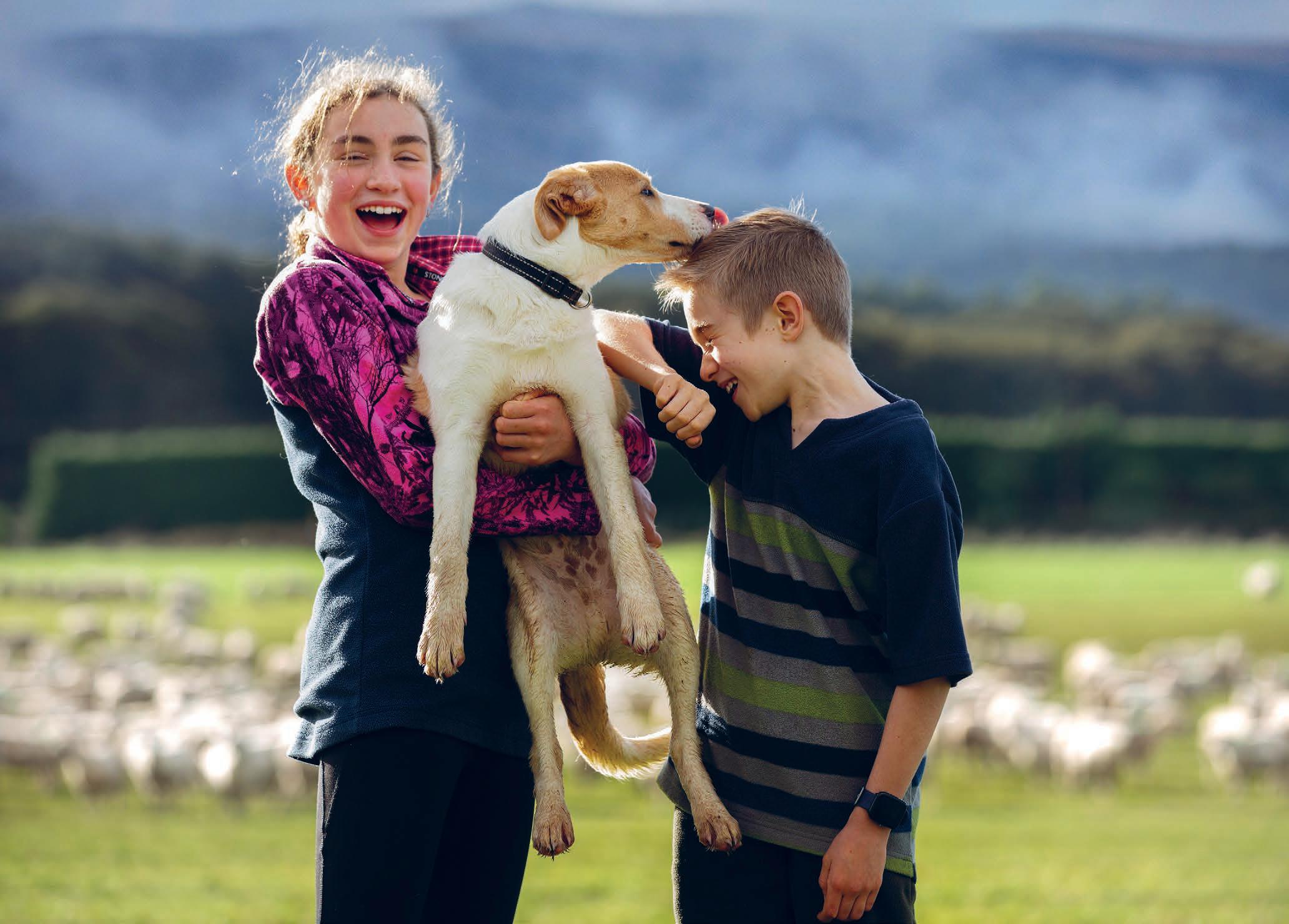
Entries for the 2024 awards are now open, and it’s FREE to enter. So are you ready?
Q: I’m only just getting started on my sustainability journey.
A: That’s okay! A farm is never finished. We’re not looking for perfection, just progress. The awards are about sharing ideas and learning from experts and other farmers who are also on their own sustainability journey – we celebrate the journey, not the destination.
Q: My mate’s farm is more impressive than mine.
A: Fantastic! You can nominate a friend on the entry form and we’ll get in touch with them.
Q: I don’t like paperwork.
A: Neither do we! Entering the awards starts with an easy online form that takes just five minutes to complete. If you’re shortlisted, our judges will arrange to come and visit your farm – so it’s more about chatting, and less about filling in forms!
Q: I’m not sure if it’s worth it.
A: Past entrants have all spoken about the valuable advice they’ve received, and the positive connections they’ve made with like-minded farmers and growers. Some have also spoken about the positive effect the awards have had on their business, providing a highly valued endorsement that builds their reputation.
BAL14020_BFEA Muster_FW Wrap_380x262mm_FA2.indd 2 7/07/23 12:38 PM
Their farming future is in your hands.
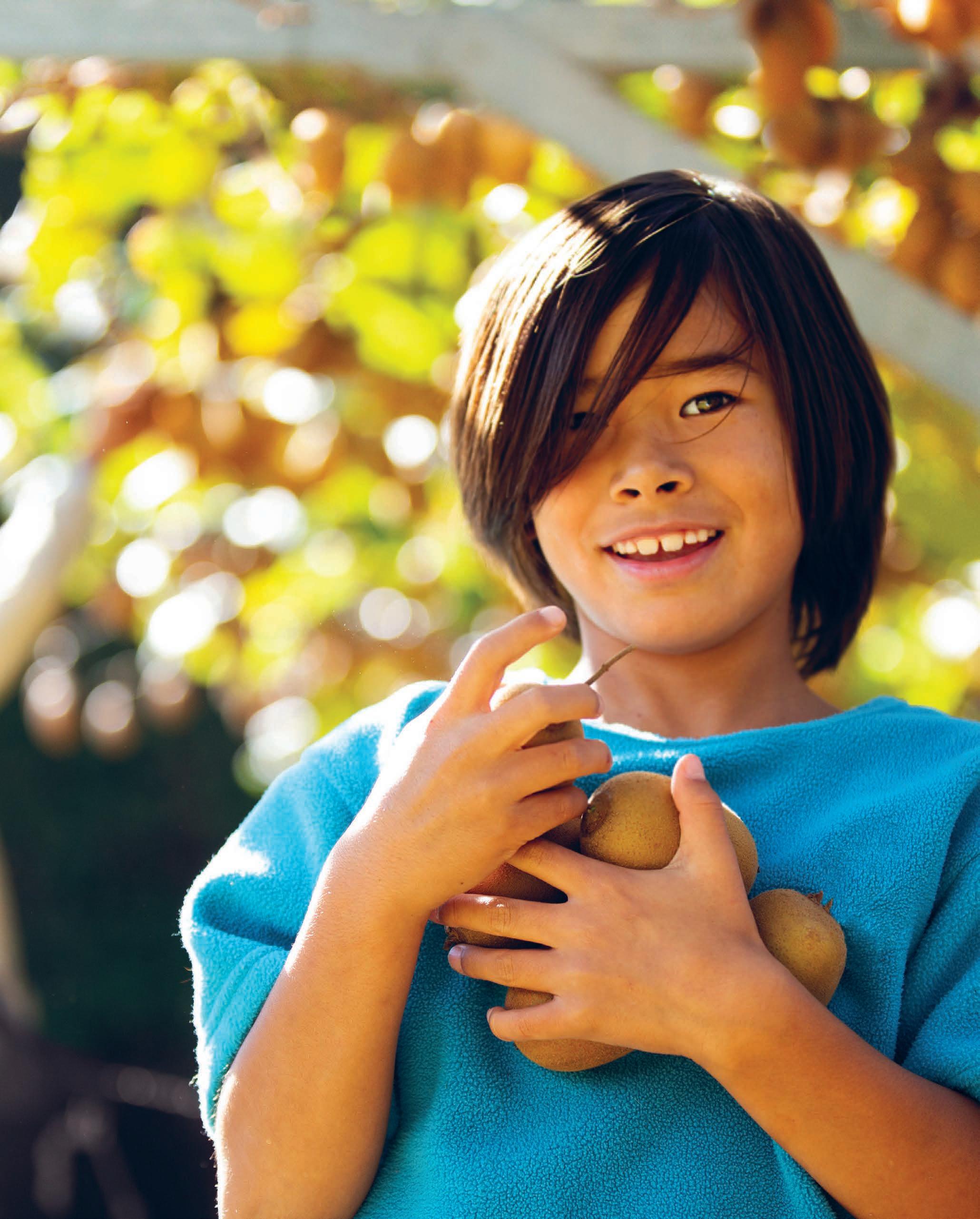

Entering the awards is an opportunity to share ideas, learn and grow.








BAL14020_BFEA Muster_FW Wrap_380x262mm_FA2.indd 3 7/07/23 12:38 PM


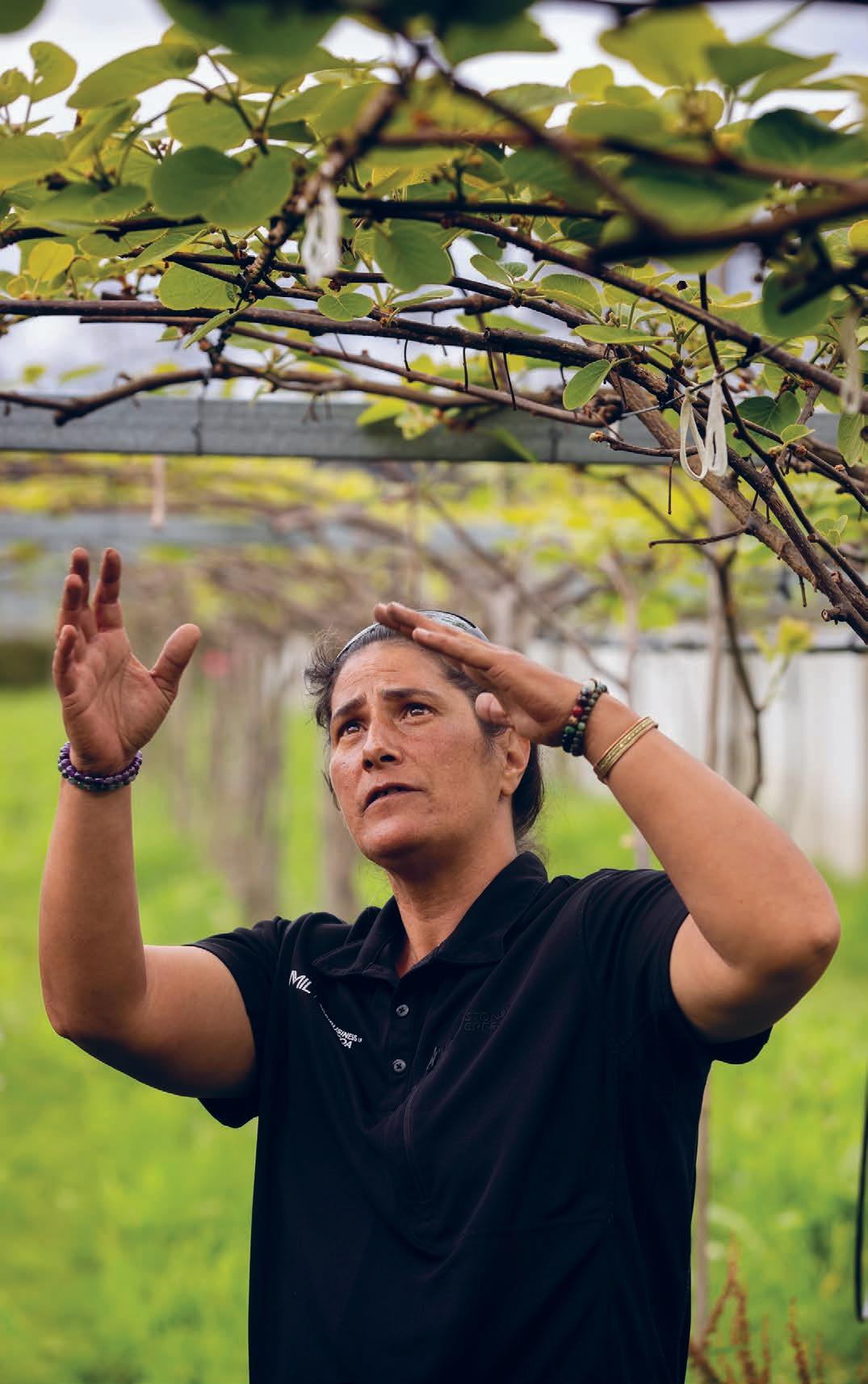





Enter the awards to help celebrate our farmers, growers and
communities.
KEVIN HALL,
2022
SOUTHLAND REGIONAL SUPREME WINNER
“
BAL14020_BFEA Muster_FW Wrap_380x262mm_FA2.indd 4 7/07/23 12:38 PM
I encourage everyone to be part of the change, embrace it, get stuck in.”
































































 Jordan Hamilton-Bicknell Wild Game
Jordan Hamilton-Bicknell Wild Game





















































































































































































































































 Maungatautari
Maungatautari


































































































